




Recently I attended two very moving services in memory ofMatthew J.Ryan,Speaker ofthe Pennsylvania House ofRepresentatives. The first was held at St.Mary Magdalen Church in Media on April 8,the day after his body lay in state in the Capitol Rotunda in Harrisburg.Matt is the first person to be so honored since Abraham Lincoln in 1865.The service was attended by over one hundred and fifty members ofthe General Assembly and by Governor Rendell and three past Commonwealth governors including Homeland Security Secretary Tom Ridge.The second service was in the magnificent Chamber ofthe House ofRepresentatives in the State Capitol on April 14,a stone’s throw from the architecturally distinguished Speaker Matthew J.Ryan Legislative Office Building,a tribute by his colleagues in every branch of State Government.
I am delighted to report that Matt’s name will now grace the facade ofyet another building,one perhaps as close to his heart as the one on Capitol Hill.Last February,the University Trustees resolved that VHUP be renamed as the Matthew J.Ryan Veterinary
Hospital ofthe University ofPennsylvania. This is the first time a building on the Penn campus has been named for a state politician since Benjamin Franklin.
Why was Matt Ryan honored in such an remarkable way and why did we change the name ofthe small animal hospital? At both memorial services,the tributes were uniform in their outpouring oflove and respect for Matt,he was revered by everyone on both sides ofthe aisle and his skills in leadership in the House are the stuffoflegend.Matt loved the House ofRepresentatives and did everything in his power to see that legislation was passed that brought the greatest benefit to the citizens ofPennsylvania.He was a brilliant leader with a steady finger on the pulse ofthe legislative agenda,he had an mischievous Irish wit and,despite his enormous power in Harrisburg,was among the most humble men you could ever wish to meet.
Sometimes,when I needed advice,I would call and ask him out for lunch.Matt’s favorite place was a rather seedy little café near his Media law office,where he would always have a chicken salad sandwich.Lunch never cost
more than $5.00 and was fascinating as he shared advice that involved millions ofdollars.
Matt loved the School and he loved his black Labrador,Magic;he probably would have been happiest ifwe had renamed VHUP as Magic’s Hospital but this name could be too easily taken amiss.Matt was a humanist who cared deeply about the people ofPennsylvania and he readily understood that veterinary medicine was ofenormous importance to the Commonwealth’s number one industry,agriculture.He was very proud of the School and supported it in every way he could during more than three decades of leadership.Our current pre-eminence in veterinary medicine is a testament to Matt’s unwavering support.
The University community,in expressing its admiration and affection for Matt Ryan,is honored to have his name associated with its Veterinary Hospital,an institution dedicated to serving the people ofPennsylvania,Matt’s people.We cherish his memory and miss him enormously.
Alan M.Kelly The Gilbert S.Kahn Dean ofVeterinaryMedicine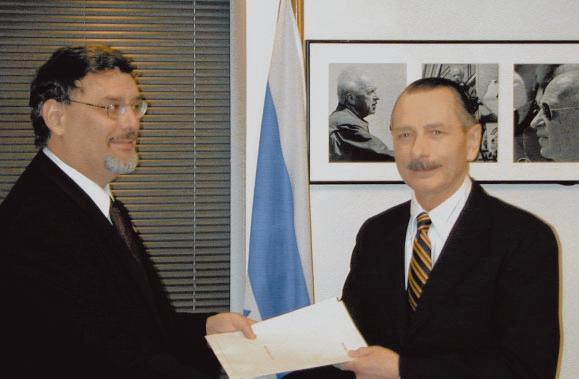
Dr.Ralph L.Brinster,V’60,Richard King Mellon Professor ofReproductive Physiology at the School,has been selected as a recipient of the 2002-03 WolfPrize in Medicine.The Wolf Prize Jury cited him “for the development of procedures to manipulate mouse ova and embryos,which has enabled transgenesis and its applications in mice.”Dr.Brinster shares the prize with two other scientists,Dr.Oliver Smithies ofthe University ofNorth Carolina, and Dr.Mario R.Capecchi,ofthe University of Utah.The three researchers were honored for developing techniques “for introducing and modifying individual genes within mouse eggs and embryos”stated the prize jury.
Dr.Brinster,a veterinarian,developed a culture system to maintain mouse and other mammalian eggs in vitro and he identified many fundamental characteristics ofegg culture.This was essential for the generation of transgenic animals.Dr.Brinster first showed that it was possible to colonize a mouse
blastocyst with stem cells from older embryos. He was the first scientist to microinject fertilized eggs with RNA and was a pioneer in the field in applying these microinjection methods to generate transgenic mice.
The WolfFoundation was established in Israel by the late Dr.Ricardo Wolfwho served as Cuba’s ambassador to Israel.The WolfPrize in Medicine has been awarded since 1978 “for achievements in the interest ofmankind and friendly relations among peoples,irrespective ofnationality, race,color,religion, sex,or political view.” There is also a prize in agriculture,chemistry, mathematics,physics and the arts.The 2002-03 WolfPrizes will be conferred by the Israeli President Moshe Katsav at a special ceremony at the Knesset in Jerusalem on May 11,2003.





Plans for the School ofVeterinary Medicine’s new $51 million Teaching and Research Building were approved last fall by the University’s Board ofTrustees.More than $43 million has been raised to date. The architectural firm ofPolshek Partnership Architects,LLP ofNew York, in collaboration with Ballinger of Philadelphia,has been selected to design the building.Polshek-designed buildings include new and renovated space for Columbia,Cornell,Stanford and Yale. The building will provide state-of-theart teaching and learning spaces,replacing the antiquated facilities currently in use. Among the areas ofinvestigation in the new building will be infectious diseases,a major reemerging threat to animal and human health;animal transgenesis and germ cell research,an exciting biomedical research area that promises healthier and more productive food animals;comparative medical genetics;and comparative oncology.
According to Veterinary School Dean Alan M.Kelly,“The facilities will enable the School to attract and retain the new generation ofresearch and clinical scientists who will train the veterinarians for the new century.Clinicians and basic researchers will work side by side,and students will be exposed to groundbreaking research.”
Marking the largest commitment to the building by a Veterinary School graduate to date,an alumnus who wishes to be anonymous has made a pledge of$600,000.As gifts ofall sizes to the new building will sustain Penn's preeminence in veterinary medicine,a special “Reserve a Seat” campaign to raise $780,000 was kicked off successfully last fall.
More than 125 ofthe School's faculty and staffresponded enthusiastically and “reserved”a seat for $3,000 each in the building’s two,130-seat classrooms. Remaining seats are being offered to alumni and friends this spring to leave their legacy.
$51 million goal
$43 million raised
Opening a new front in the battle against Alzheimer’s disease,scientists at the School have found that a protein long associated with the disease inflicts grave damage in a previously unimagined way:It seals offmitochondria in affected neurons,resulting in an “energy crisis”and buildup oftoxins that causes cells to die.This pathway,the first specific biochemical explanation for pathologies associated with Alzheimer’s,was detailed in the April 14 issue ofthe Journal ofCell Biology.
While the normal function ofthe amyloid precursor protein (APP) remains unknown, senior author Dr.Narayan G.Avadhani and his colleagues have determined that a mere 50amino-acid stretch ofthe protein wreaks havoc by essentially starving mitochondria and the cells they nourish.
“We found that when APP leaves the nucleus,it can be directed both to mitochondria and to the endoplasmic reticulum,”said Avadhani,Harriet Ellison Woodward Professor ofBiochemistry and chair ofthe Department ofAnimal Biology in the School.“APP has an acidic,negatively charged region that causes it to jam irreversibly while traversing protein transport channels in the mitochondrial membrane.This hampers,and eventually completely blocks,mitochondria’s ability to import other proteins and produce cellular energy.”
As ifsuffocating the cell’s power plant weren’t enough,jammed APP proteins also damaged the mouse neurons studied by Avadhani and co-author Dr.Hindupur K. Anandatheerthavarada in a second way.The end ofthe protein left dangling outside the mitochondrion contains a toxic product called A-Beta.The researchers found that this toxin, a known component ofthe brain plaques and tangles that are a hallmark ofAlzheimer’s,is cleaved from the rest ofthe immobilized protein and accumulates in the cell.
“Researchers have observed many biochemical and biophysical phenomena associated with Alzheimer’s disease,”said Anandatheerthavarada,research assistant professor ofbiochemistry and the paper’s first author,“but it has remained unclear whether these are causes ofAlzheimer’s or merely side effects.The pathway we observed,which leads directly to common symptoms,is the first with a demonstrated ability to cause the neuronal death associated with Alzheimer’s
disease.”
The results are consistent with the progressive nature ofAlzheimer’s and other neurodegenerative diseases,the scientists said.As pores in the mitochondrial membrane clog with proteins – inaccessible to enzymes that might normally degrade them – cellular function is steadily and inevitably reduced until cell death, reached when APP succeeds in suffocating all the cell’s mitochondria.
holds that each ofthe proteins produced in the nucleus can be directed to only one location in the cell.In APP’s case,the Penn scientists have shown the targeting sequence within the protein’s N-terminal directs it to at least two locations,the mitochondrion and endoplasmic reticulum.
The implication ofmitochondrial failure is unexpected because most Alzheimer’s researchers,believing the mitochondrion was not on APP’s itinerary,have focused on the protein’s effects on other organelles.In fact, Avadhani and Anandatheerthavarada found that mitochondria appear to be the only organelles whose membranes have trouble handling APP.
It remains unclear whether APP gets stuck in mitochondria’s protein entryways because of its negative charge or bulkiness attributable to improper protein folding.Avadhani and Anandatheerthavarada plan to study the question, which could eventually yield medications to correct the problem.
Mitochondria showing the translocation-arrested APP proteins.Circular images show confocal immunofluorescent images of mitochondria.
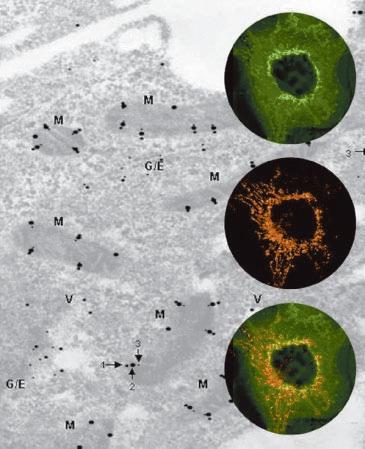
Avadhani and Anandatheerthavarada’s results put a dent in cell biology dogma,which
“A mutant version ofAPP without the region that’s prone to jamming passes into the mitochondria without a hitch,”Avadhani said. “This suggests that pharmaceuticals could be developed to fix this domain,either by neutralizing its charge or folding it more tightly.”
Avadhani and Anandatheerthavarada were joined in this research by Dr.Gopa Biswas and Mary-Anne Robin,both ofthe School’s Department ofAnimal Biology.Their work was funded by the National Institutes ofHealth.
New Bolton Center’s unique orthopedic surgical facility with its pool recovery system is undergoing a $2 million renovation and expansion.A new,state-of-the-art operating room for large animals will be constructed in the C.Mahlon Kline Orthopedic and Rehabilitation Center adjacent to the current operating room.That will be refurbished and will be used for minor surgeries and bandage changes.An additional recovery stall will be built adjacent to the recovery pool used for horses emerging from anes-
thesia.The pool will be altered slightly by the removal ofthe ramp.
While the Kline Center renovations are under way,equine orthopedic surgeries will be handled in an operating suite in another building.Patients will be recovered from anesthesia in a stall.
It is anticipated that the renovation and expansion ofthe orthopedic surgical facilities will be completed by the end ofthe summer of2003.
Carriage buffs will come to the Philadelphia area the weekend ofJune 13,14 and 15 for drives and a gala sponsored by A Weekend in Old Saratoga,a group ofcarriage enthusiasts that has raised funds for a number ofcauses. This year,instead ofgoing to Saratoga,N.Y., the group has decided to come to Philadelphia for A Weekend in Old Philadelphia and focus the fund raising efforts on two area institutions,New Bolton Center and the Devon Horse Show Foundation.
The weekend kicks offwith a country drive and luncheon in the Radnor Hunt area on June 13.Saturday,June 14, “An Afternoon in the Park,” the famous Thomas Eakins painting ofFairman Rogers driving his four-in-hand comes to life in Fairmount Park in Philadelphia.The carriages,many antique,assemble at Lemon Hill in Fairmount Park for a drive at 10:30 a.m.along the Kelly Drive to the Falls Bride.The carriages will cross the Schuylkill River here and return through the western part ofthe park to Center City and
back to Lemon Hill by 3:30 p.m.The First City Troop,the nation’s oldest cavalry unit,will accompany the carriages.It is splendid opportunity to see yesteryear’s transportation –superb horses and beautiful carriages – driven and occupied by people in their “Sunday best” which includes top hats for the gentlemen and beautiful hats for the ladies.
Fairman Rogers had close ties to the University ofPennsylvania,he graduated Phi Beta Kappa in 1853 and served on the University’s Board ofTrustees from 1871 to
“whip,”he was the first to introduce four-inhand driving as a pastime in Philadelphia.Mr. Rogers wrote the Manual ofCoaching in the years before his death – a work that has become a classic in its field.He donated a unique collection ofbooks,pamphlets and periodicals to the University,known as The Fairman Rogers Collection on the Horse and Equitation,that now resides in the rare book collection ofthe Van Pelt Library.
Saturday evening,festivities continue at “Ardrossan,”the estate that provided the inspiration for the movie “Philadelphia Story.”A black tie gala,“The Philadelphia Story,”will be held.A spectacular dinner dance and a silent auction round out the evening.On Sunday, June 15,the weekend concludes with another carriage drive in the area near Devon.
1876,and was also a member ofthe special trustees committee that recommended the establishment ofa veterinary department in 1884.As an accomplished horseman and
The Bernice Barbour Foundation has awarded a full tuition and living expenses scholarship to Amanda Parton,V’06.This scholarship,which also includes funding during an internship after graduation,is the largest ever received by a student at the School.
The Bernice Barbour Foundation was established in 1986 by the late Bernice Babour who, throughout her life,devoted much ofher thought,energy and resources toward making the lives ofanimals happier and healthier.The Foundation has supported projects involving animals ranging from marine mammals to birds and burros.The scholarship at Penn is the third at a veterinary school.
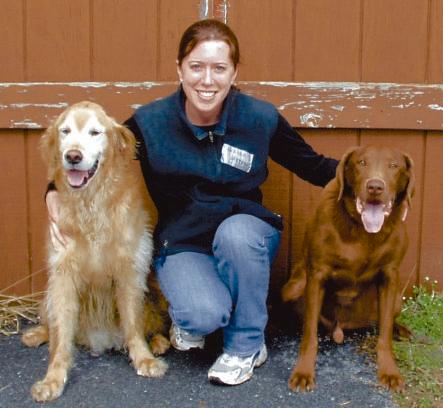
Amanda Parton,since childhood,wanted to be a veterinarian.She graduated with honors from Lafayette College in 1998 and worked for three years for Merck and Co.,Inc.in vaccine operations.While in college and at Merck, Amanda volunteered at veterinary hospitals. Now, in addition to her heavy course load,
she still finds time to work as a nursing assistant at the School’s Ryan Veterinary Hospital.She is also active in various student organizations.Amanda is very intrigued by the interaction between people and animals.Specifically,she is interested in search and rescue animals,and animal therapy for Alzheimer’s patients and the disabled.Ultimately,her goal is to pursue a residency and board certification in a specialty area ofveterinary medicine.
“I am in awe ofthe generosity of the Bernice Barbour Foundation.The financial burden ofveterinary school is quite stressful.This scholarship will allow me to focus even more on my education and will open new doors of opportunity as the financial burden has been lifted.So far,my experience at Penn has been amazing.I look forward to the future
A Weekend in Old Saratoga is a charitable organization devoted to fund raising through carriage drives and gala events.During recent years,the group has raised more than $750,000 for New Bolton Center.This has resulted in increased facilities and equipment for the treatment ofequine patients.
For more information on the carriage drives and the gala,please contact Pat Hall at 610. 444.5800,ext.2500 or <phall@vet.upenn.edu>
and the chance to take full advantage ofthis gift from the Bernice Barbour Foundation as I follow my dream.”
Many ofRyan Veterinary Hospital’s postsurgical patients wear patches on their rumps, sticky plasters that slowly release painkillers into the animal’s bloodstream through the skin.The animals appear to be calm and comfortable.They don’t fret,pant or whine.“We manage acute pain,such as post-operative pain,very well,”says Dr.Dorothy Brown, assistant professor ofsurgery.“But we are not so adept at managing chronic pain in our patients.”Veterinary medicine is paying increased attention to the management of chronic pain as animals are living longer,just like people.And they have the same kinds of ailments such as arthritis,disk disease,cancer and other ailments.
“Owners ask veterinarians to treat chronic pain in their pets,”says Brown.“We have a limited number ofdrugs at our disposal and we are just learning how to manage chronic pain in pets.”Painkillers can generally be divided into two categories,opiates and nonsteroidals.“In essence,painkillers either come from the poppy or tree bark,”says Brown. “The products on the market are all derivatives ofthese ancient ingredients.People have manipulated the properties ofthe poppy and aspirin and have developed a multitude of products.Some are helpful to our patients, others are lethal because animals metabolize these substances differently.”
To manage pain in animals is difficult. They can’t verbally communicate that they are in pain or where they hurt.Often signs that an animal is in pain are subtle and it takes a very observant owner to pick up these frequently slight behavior changes.And sometimes a slowing down is assumed to be due to advancing age and not pain.It is the owner who assumes,by the pet’s changed behavior,that it is in pain.The veterinarian then has to decide what kind ofpain it is – acute or chronic and how severe it is.“We have to rely on the owners for information,”says Brown.“They have to tell us about behavioral changes and from that we have to decide what we are dealing with.It is difficult,particularly in chronic pain cases.The owner’s idea ofsevere may be different from the veterinarian’s notion ofsevere. We don’t have behavior based chronic pain scales for dogs or other pets.”
Such pain scales exist in human medicine and they are used with great frequency.Many hospitals regard pain as the fifth vital sign,
similar to blood pressure,pulse,temperature and respiratory rate,and have institutionalized pain assessment.This is particularly important with patients who do not communicate well. In human medicine it is known that chronic pain is frequently undertreated;this may be due to patients’reluctance to seek medical help,to resignation ofliving with pain,or to physicians’hesitation to prescribe a stronger medication.
“We don’t know whether chronic pain is undertreated in veterinary medicine,”says Brown.“We have to rely on the owner to tell us whether the animal is more comfortable after being given pain medication.We don’t know whether we have maximum pain relief because the animal can’t tell us and we have no behavior based pain scales for animals.”
Dr.Brown is exploring the development of such pain scales for dogs.She is conducting a study ofdogs with bone cancer.This disease also occurs in humans and the stages ofpain severity as the disease progresses to the endstage are known.The cancer presents the same histologic picture,whether the tumor sample comes from a human or a dog.It affects the same population – primarily large males,and can have a similar age ofonset in both species.
Brown is treating her canine patients with an experimental pain killer and the owners report on their animal’s response to the drug, whether they perceive the pain as being relieved and to what extent.Brown has devel-
oped several questionnaires with the help of Dr.John Farrar from Penn’s School ofMedicine.Owners complete it by answering questions about the dog’s behavior and the amount ofpain they feel the animal is experiencing prior to and after administration ofthe drug. Brown hopes that this year-long study will yield better information on chronic pain in canines and point to a way to manage it.It may also aid in the development ofchronic pain scales.
“There is no specific marker for pain that we know,”Brown says.“Certain values,such as cortisol,go up when an animal is in pain.But they also go up when an animal is stressed.If you anesthetize two animals,spay one,do nothing to the other,both will have the same stress markers even though the one that experienced the surgery may have pain.So we are dependent on observation.This is where behavioral pain scales come in.They would enable the veterinarian to better tailor pain killing drugs to the patient.”
The study is not yet completed and it will take many months ofwork to evaluate the questionaires.One thing is clear,there is a need for objective evaluation ofchronic pain. “When I contacted referring veterinarians for leads on probable cases,I was overwhelmed by the response,”says Brown.“There is a great need to learn more about chronic pain in pets and how to manage it.We are just at the beginning.”
In April,ground was broken for a teaching garden at New Bolton Center.The garden will contain toxic and poisonous plants and is established in cooperation with the Penn State Cooperative Extension.Penn State's Chester County master gardeners have designed and are installing the garden.This is the only garden ofthis type in the midAtlantic region
“The garden will serve as an important teaching tool,”says Dr.Robert Poppenga, associate professor ofpathobiology.“It brings together,in one spot,as many plants ofveterinary concern as possible.This makes it much easier for our students to observe the plants at various stages ofgrowth for identi-
fication purposes.It also allows the planting ofsome plants that are not native to the area.”
“The garden will contain plants potentially poisonous to animals such as cattle and horses,”says Mr.Thomas Bare,lead master gardener on this project.“We plan to eventually have growing here at least 30 species of plants that can sicken or poison these large domestic animals.The plants,some of medicinal interest,will be displayed in attractive beds so that students and other interested people can examine and identify them in a natural growing environment.”Craig Rybinski,a master gardener,designed the garden and planned the construction phases.
At first glance,a collaboration between a School ofVeterinary Medicine and a School of Social Work may seem unlikely,perhaps even unnecessary.Not so at Penn,where one ofthe Vet School’s multidisciplinary research centers – the Center for the Interaction ofAnimals and Society (CIAS) – focuses its attention on the study ofhuman-animal relationships.In fact,collaboration between the two schools was first established almost 20 years ago.Now, Dr.James A.Serpell, director ofthe CIAS, wants to enhance this link because ofthe unique knowledge and skills that social workers can bring to the study ofhuman-animal interactions.
It’s been just over a year since Symme Trachtenberg,MSW,LSW,director ofCommunity Education at The Children’s Hospital of Philadelphia (CHOP),signed-on to be the liaison between the two schools,and the relationship is already in full bloom.As ofthis printing,there are five collaborators from the School ofSocial Work who are actively contributing to the work ofthe CIAS.
Current projects underway include the creation ofan educational program called,“Kids Caring for Pets,”that teaches children about the responsibilities ofadopting and caring for pets. This program – developed by RyanVeterinary Hospital staffmembers Dr.Stephen Mehler, intern; Sally Powell,Critical Care/ES nursing supervisor;and Alison Seward,behavior technician – is currently being piloted at the new Sadie Alexander University ofPennsylvania Partnership School and other schools in West Philadelphia.Since November,the Kids Caring for Pets Program has visited four schools and done ten presentations.Hundreds ofchildren have participated,and preliminary data suggest that the program is having a positive impact on students’understanding ofwhat iftakes to keep pets happy and healthy.
The social work group is also collaborating with CHOP to evaluate its animal visitation program,known as PAW Partners.This program,which provides opportunities for children and their families to interact with visiting animals,has been well received and is highly successful,and the social work group hopes to take a more objective look at its benefits.Dr. Kinnevy and Ms.Levinthal are studying the link between child abuse and animal abuse. They are also using diagnosis codes from the
Vet School’s patient database to map clusters of companion animal disease within the city.This information will be used to target educational and community outreach efforts.
If you would like additional information on the collaboration between the Schools ofVeterinary Medicine and Social Work,or you know ofa school that would like to host the “Kids Caring for Pets”educational program, please contact Ms.Kathy Kruger at 215-7460096,or kkruger@vet.upenn.edu.Alternatively, you can learn more about the work ofthe CIAS by visiting:www.vet.upenn.edu/ ResearchCenters/CIAS/

Researchers at the School have developed a new DNA-based test for an inherited disease in the schipperke,a breed ofdog.The disease, mucopolysaccharidosis type IIIB (MPS IIIB,also known as Sanfilippo syndrome,type IIIB),is an autosomal recessive disease that is classified as a lysosomal storage disease.Other better-known lysosomal storage diseases that occur in humans include Tay-Sachs disease and Gaucher disease.
This is the first time that MPS IIIB has been diagnosed in any companion animal.The symptoms ofMPS IIIB in the schipperke are caused by serious and progressive damage to the brain and include tremors,stumbling,and falling.Symptoms in the dog first appear at two to three years ofage.The brain disease progresses until the dogs are no longer able to stand,walk,eat,drink,or eliminate without assistance,and owners have had to elect euthanasia for their pets one to two years after the onset ofsymptoms.
This DNA-based test is the latest in over a dozen different mutation-specific DNA-based tests for inherited disorders offered or developed by the researchers in the Section of Medical Genetics at the School.
The initial schipperke case came to the attention ofPenn researchers in late 1998,when Dr.Urs Giger and colleagues in the Section of Medical Genetics at the School identified MPS IIIB in a dog in samples that had been submitted for analysis to the School’s metabolic genet-
ic screening laboratory.Since then other dogs have also been studied in the breed.The identification ofthe mutation and development of the test was performed by Dr.N.Matthew Ellinwood,a post-doctoral fellow in comparative medical genetics.The DNA testing of schipperkes for the MPS IIIB mutation will be conducted through the School’s Josephine Deubler Genetic Disease Testing Laboratory.
“As devastating as this disease is,we are fortunate that we can help eradicate the condition through testing that identifies animals that are affected or are carriers,”says Ellinwood.“This allows breeders to eliminate affected animals from their breeding program and mate carriers only to animals that do not carry the disease. Eventually the schipperke breeders,using this test,will be able to eliminate this disease in the breed.”
“Unfortunately,the mutations in humans are so rare,and so varied,that it is not practical to test people routinely,nor are there routine and effective ways to screen newborns children for the disease.
“One ofthe most devastating things is that in some families the eldest child in a family, diagnosed at 3-5 years ofage,may have younger siblings who also have the disease but have not yet started to have symptoms,so that parents will confront more than one devastating diagnosis.Finding effective ways to treat this
(continued on page 9)
West Nile Virus (WNV) primarily causes disease in birds and is usually spread by mosquitoes but it occasionally causes disease in horses.Horses become infected with WNV by the bite ofa mosquito which previously (at least six to ten days earlier) fed on a bird infected with WNV.Infection does not always cause clinical disease in horses.When horses have clinical signs,the disease can be very serious. There were 738 clinically affected horses reported in the United States in 2001 and over 14,000 reported in 40 states in 2002.Pennsylvania had 97 equine cases in 2002.
Horses with West Nile Virus can have a variety ofclinical signs.They may have a mild flulike syndrome with fever,depression,listlessness,and occasionally somnolence.When fever occurs it may be biphasic with the early fever associated with mild flu-like signs and a second fever a week later associated with the onset of more serious neurologic signs.Many cases never develop a fever.Some cases will develop local muscle contractions and an unusual muzzle twitching.They may show more serious neurologic signs including incoordination and ataxia (stumbling),circling,aimless wandering, head pressing,and hyperexcitability followed by convulsions,coma,and death.In some outbreaks a progressive hind limb paresis (incoordination,ataxia,stumbling) progressing to complete hind limb paralysis (inability to rise behind) and finally front leg involvement is reported as typical.Simultaneously,brain signs will be progressive (depression,somnolence or hyperexcitability,convulsions,coma).Death may occur within hours or after 5 to 10 days of development ofserious signs in up to a third of the cases.Survivors will recover with the most dramatic improvement within three weeks.
West Nile Virus is primarily transmitted between birds by mosquitoes.Occasionally virus-carrying mosquitoes will bite mammals exposing them.Based on recent experimental inoculations carried out on horses,horses are not involved in the transmission cycle ofWNV. That is,horses are terminal hosts because they do not maintain a sufficient viremia (presence ofvirus in the blood) to infect mosquitoes or other mammals.Previous studies in horses support this conclusion.This means that infected horses will not transmit WNV to other horses or to people.So an infected horse is not a threat to other horses in contact with it and
people cannot contract West Nile Fever by caring for an infected horse.However,special care should be taken when handling blood,spinal fluid,or nervous tissue from suspect animals since these may contain virus.
The virus is introduced into an area through infected birds.Some infected birds develop neurologic signs such as loss ofcoordination,tremors,abnormal head posture,circling,convulsions followed by death.The appearance ofdead birds in an area may be an
According to the Epidemiological Bulletin,Pan American Health Organization,people can take some basic precautions to limit their exposure to the virus:
•Put screens on windows and block any holes in the house where mosquitoes can enter.
•Wear long pants and long-sleeved shirts, particularly when remaining outdoors for extended periods,especially at times when mosquitoes are active.
•Minimize outdoor activities at dawn and dusk,when mosquitoes are most likely to bite.
•Use insect repellent,always following directions on the package.
•Herbal and ultrasonic repellents are ineffective against mosquitoes.
early warning that the virus is present.When handling dead birds that may have died from WNV infection,care should be taken.There is no evidence that people can catch this disease from dead birds,but the Centers for Disease Control and Prevention recommends that no one should ever touch any dead animal barehanded.Call your local health department for proper procedures for handling ofdead birds.
How can horses be protected from WNV infection ifthe virus enters the area? One key is mosquito control to stop the bird-mosquito infection cycle.The primary mosquito carrier transmitting the disease to horses has not been identified.Over 30 species ofmosquitoes have been found positive for WNV.A frequently identified species is Culex.This mosquito spends its entire life within a range ofabout 1000 yards.Thus local control can be very effective in stopping WNV transmission by this mosquito.With all mosquito species,the most effective method ofmosquito control is to destroy the mosquito larval habitat. Culex mos-
quitoes can breed in any puddle that lasts more than four days.So it is important to reduce the amount ofstanding water available for breeding such as water troughs (should be cleaned at least once or twice a week),water buckets not in use,plastic wading pools,bird baths,wheelbarrows,clogged roofgutters,discarded tires, tin cans,plastic containers,ceramic pots or any water-holding container.
Although less effective than preventing mosquito breeding,it is advisable to make efforts to limit the horse’s exposure to adult mosquitoes.Because different mosquito species have different feeding preferences and we are unsure which mosquito species transmits the disease to horses,specific stabling recommendations can not made.One recent study suggested that horses stabled at night are less frequently affected by the virus,so nighttime stabling maybe helpful.Also,insect repellent approved for horses can be used (always follow label instructions),but insect repellent should not be used as the sole control method.
Another key to prevention is vaccination.A conditionally licensed WNV vaccine is available.Conditional licensing means that the product has been shown to be safe,pure,and have a reasonable expectation ofefficacy in preventing illness caused by WNV.Widespread use ofthis vaccine over the past year suggests that it is safe but its efficacy in preventing disease from WNV remains unproven.
An anonymous faculty member has made a $100,000 gift to the Department ofClinical Studies-Philadelphia to establish an endowment to fund basic research projects by clinical faculty. A gift of$100,000 for the Teaching and Research Building has been made by Louis DeNaples.The Montgomery County Kennel Club contributed to the Josephine Deubler bridge in the Teaching and Research Building and to the Josephine Deubler Genetic Disease Testing Laboratory.The Devon Dog Show Association made a gift to the Ryan Veterinary Hospital.
The Gerald B.Shreiber Foundation made a gift of$15,000 to the Special Species Clinic in appreciation ofthe care Mr.Shreiber’s pet “Goose-Goose”received.The funds will be used to purchase a special endoscope for sole use in the Special Species Clinic.
New Bolton Center has acquired a laparoscope for the use in embryo transfer and insemmination ofsheep and goats. Dr.Regina Turner, assistant professor ofreproduction at New Bolton Center,explains the benefits ofthe new instrument.
Laparoscopic artificial insemination in sheep and goats currently is the preferred method for breeding these small ruminants with frozen-thawed semen.Using the laparoscope,semen is deposited directly into the uterine horn,thus placing the sperm in close proximity to the site offertilization.This increases the chances for pregnancy,particularly when dealing with small numbers ofsperm (as is the case with frozen semen).
Before an animal can undergo this procedure,her estrous cycle must be synchronized with hormones.This allows ovulation to be very exactly timed.At around the time ofovulation,the procedure is performed.The ewe may or may not be sedated and a local anes-
thetic is injected at the surgical site.The ewe then is suspended by her hind legs in a specially-designed cradle.This position helps to insure that the rumen and intestines are not in the way ofthe surgery.A small incision (usually less than a centimeter) is made through the animal's body wall and into her abdomen.The laparoscope is inserted through the cut.The uterus and ovaries generally are easy to see through the laparoscope.Once the reproductive tract has been identified,a second,similar incision is made into the abdomen and a small insemination instrument containing the semen is passed through the cut.The surgeon then can watch through the laparoscope and guide the insemination instrument to the uterus where a small needle at the end ofthe insemination instrument is used to puncture into the uterus. Semen then is injected directly into the uterine lumen.The instruments are withdrawn and the small holes are closed with one suture each.In the hands ofan experienced surgeon,the entire procedure can take less than 10 minutes.Most
(continued from page 7)
rare disorder are going to be challenging and we hope that by studying the disease in the dog, we will be able to make the progress that these children and families hope for.”
Dr.Ellinwood,who has judged working hunting dogs,presented his findings at the beginning ofApril to a meeting ofschipperke enthusiasts at this year’s annual National Specialty Show ofthe Schipperke Club of America,in Dallas,Texas.“I am really very pleased to be able to have a part in helping to improve the health ofthese dogs,by allowing the breeders to use the power ofa DNA test to end forever a terrible disease.”Unfortunately, children with this rare disease and their families still wait for developments in research that may bring promise ofan effective treatment.Helping to eliminate this disease from this dog breed was the ‘easy part,’”says Ellinwood.
The researchers benefited from the knowledge gained in the field ofhuman medicine and genetics.It took human medical science over thirty years to understand the genetic basis ofthis disease,from the time the syndrome was
first identified in 1963,until 1996,when DNA mutations could be identified in people.Using this knowledge the researchers at Penn were able to identify the mutation in the schipperkes in a relatively short period oftime.
The research on the disease-causing mutation in the schipperkes was funded by a grant from the National MPS Society awarded to Dr.Mark Haskins,professor ofpathology,in an effort to make progress in understanding MPS IIIB and to help in developing treatments for children with this disease.The incidence of MPS IIIB in the human population is approximately one in every 73,000 live births.The condition in children first appears as delayed development in early childhood,and progresses through childhood with severe metal deterioration leading to dementia.The disease is ultimately fatal,with most children dying in their teenage years.At the present time,there is no treatment that has been proven effective.To learn more about this and similar diseases in children,visit the National MPS Society’s web site at <www.mpssociety.org>.
ewes stand as soon as they are released from the cradle and suffer no after effects.As with any surgical technique,there can be complications. But these are rare and usually are minor.
Pregnancy rates vary depending on the breed,the season and the semen quality.Highly fertile ewes under excellent management and bred in season can experience pregnancy rates as high as 80%,although more typical ranges are from 40 to 70% in season.These kinds of pregnancy rates make this procedure very practical for valuable animals and open up the possibility ofusing imported frozen semen from some ofthe most valuable males in the world.
Another assisted reproductive technique that is gaining in popularity with small ruminant breeders is embryo transfer.Embryo transfer greatly increases the potential number ofoffspring that a single,valuable female can produce in a year.This can be ofgreat economic benefit to producers and also can help propagate valuable genetics on the female side.For this procedure,the donor animal's estrous cycle and the estrous cycle ofa group ofrecipient (surrogate) females are synchronized hormonally.Additionally,the donor animal is given hormones that make her ovulate a very large number ofeggs (sometimes more than 10 each cycle).
The donor is bred either naturally or laparoscopically at a set time.Several days after the breeding,the donor ewe is placed under anesthesia.A surgical incision is made in her abdomen and her uterus is exteriorized.A small incision is made in the uterus and a tube is threaded into the uterine lumen.Flush media is injected through the catheter and collected.Hopefully, this media rinses the embryos out ofthe uterus. The media is searched under a microscope and embryos are identified.The incision is sutured closed and the ewe recovers from the anesthetic. Any resulting embryos can be frozen for long term storage or they can be immediately transferred into a synchronized recipient.
For the actual embryo transfer,the recipient ewe is sedated and an appropriate number of embryos are placed into her uterus with the help ofthe laparoscope.The recipient ewe then carries the pregnancy for the donor ewe.As many as 15 embryos can be recovered from a single flush,although more typically the number ranges between 5 and 10.Actual success rates depend on the breed,the time ofyear,the quality ofthe semen and the management of the donor and recipient animals.
Dr.Kathryn Michel, assistant professor of nutrition and chief,Section ofMedicine,was honored by the American College ofVeterinary Emergency and Critical Care with an Award for Scientific Achievement for contributions in critical care nutrition.She shares this award with Lisa Freeman ofTufts School ofVeterinary Medicine.
Dr.Gerhard Schad,professor ofparasitology, was elected Honorary Member ofthe Helminthological Society ofWashington in October. He chaired a symposium on the molecular and neurobiology ofparasitic nematodes and gave a paper on the same subject at the meeting of the American Society ofTropical Medicine and Hygiene in Denver in November.
Dr.Sue McDonnell, associate professor of reproduction,is the author of A Practical Field Guide to Horse Behavior: The Equid Ethogram, published by Eclipse Press.The book is based on studies ofequid behavior under natural and feral conditions.It includes the work ofmany Penn veterinary students and alumni on behavior in NBC’s semi-feral pony herd (Elizabeth Ewaskiewicz,V’98, Michael Fugaro,V’97, Melissa Lutz,V’99, S amantha Murray,V’01, Amy E.Poulin,V’04).
Lecture.
Three faculty members were promoted to full professor: Dr.Robert J.Washabau,V’82,to professor ofmedicine, Dr.Mattie J.Hendrick, V’78,to professor ofpathology,and Dr.James Ferguson,V’81,to professor ofmedicine.
Dr.Pamela Wilkins, assistant professor of medicine,presented a paper at the AAEP Meeting in Orlando entitled,Botulism in Foals:A Survivable Disease.Dr.Wilkins and Dr.Brett Dolente,V’96,instructor in medicine,received a $30,000 three-year grant from the American College ofVeterinary Internal Medicine Research Foundation to study the effect oflow molecular weight heparin treatment in horses with diarrhea and disseminnated intravascular coagulation.
Dr.Adrian R.Morrison,professor ofbehavioral neuroscience,delivered an invited lecture in March at the Congress ofthe Federation of Latin American Sleep Societies in Mexico.
Dr.Corinne Sweeney,professor ofmedicine, current president ofthe American Association
Safety Association and Applied Research Ethics National Association in San Diego in February 2003.Dr.Benson presented these topics: Special issues with transgenic animals,IBC’s, and Institutional Animal Care and Use committees and Effective organizational models: reporting,structure,staffing,responsible officials and more.
In March 2003,Dr.Benson gave a talk at the Philadelphia Society for Promoting Agriculture meeting.
Dr.Craig Clifford,resident in oncology, recently received a grant from the Winn Feline Foundation for a project entitled “Plasma vascular endothelial growth factor (VEGF) concentrations and tumor VEGF expression in cats with vaccine associated sarcomas (VAS).”Coinvestigators include Drs.Karin Sorenmo and Ken Drobatz.Dr. Clifford presented talks at the Iams Imaging Symposium in April and at the AAHA Symposium in March in Phoenix.
Dr.McDonnell was a speaker on behavioral topics at the AAEP meeting in Orlando in December.
Dr.Eric Birks, assistant professor ofsports medicine,received a grant from EquATec,Inc. in support ofhis study on inhaled nitric oxide.
Dr.Mike Ross,professor ofsurgery,is coauthor with Sue J.Dyson of Diagnosis and Management ofLameness in the Horse, published W.W.Saunders.This comprehensive text book consists of130 chapters divided into ten parts and comes with an integral CD-ROM that allows the reader to see video clips ofa variety ofthe conditions referred to in its pages.While it is a detailed text book that any equine specialist will find very useful,it is also a book that may have its uses as a reference work for any horse-owner,trainer or stable manager.
Dr.David Nunamaker,V’68,Jacques Jenny Professor ofSurgery,presented the Milne State ofthe Art Lecture at the AAEP meeting in December in Orlando.He presented two topics:On Bucked Shins,and On Bone and Fracture Treatment in the Horse.Dr.Nunamaker is the seventh person selected to give the Milne
ofVeterinary Clinicians (AAVC),hosted the organization's annual Department Heads & Hospital Directors meeting on the Penn campus in March 2003.The mission ofthe AAVC is to enhance the quality ofand be an advocate for veterinary clinical teaching,service,and research.The AAVC administers the Internship and Residency Matching Program.Dr.Sweeney in 2003 was named a National Academies of Practice Distinguished Practitioner.
Dr.Charles Benson,professor ofmicrobiology, Dr.Gary Smith,professor ofpopulation biology and epidemiology,and Dr.Helen Aceto, V’97,made presentations on rapid diagnostic/ detection systems at the 2003 Penn Annual Conference in the session,“Agroterrorism and Biosecurity ofthe Food Supply.”
Dr.Benson was an invited participant at a conference,“The future faces ofInstitutional Biosafety Committees:Evolving roles and responsibilities,upcoming challenges and opportunities,”sponsored by the NIH Office of Biotechnology Activities,NIH Office ofLaboratory Animal Welfare,American Biological
Dr.Gary Smith wrote,produced and directed a pantomime in the British style called “Aladdin and his Magical Lamp.”It played to rapturous applause (alright,a few people clapped) for three nights in January. Dr.Smith also gave a talk on agroterrorism to the New York Farmers Club at the Union Club in New York City in February.
Dr.James Serpell,Marie A.Moore Associate Professor ofHumane Ethics and Animal Welfare,received a grant of$34,000 from the AKC Canine Health Foundation to help with the development ofnew methods for measuring behavior and behavioral problems in dogs. Together with Symme Trachtenberg ofThe Children’s Hospital ofPhiladelphia and the School ofSocial Work,he has also been offered a grant of$96,664 from the Annenberg Foundation's Sunnylands Trust for a new initiative to explore the potential ofanimal-assisted therapeutic interventions in the treatment ofadolescent mental disorders.Some ofthese funds will be used to support a major conference on the topic in March 2004.
Dr.Robert Eckroade, associate professor of pathology,presented a paper at the National Poultry Improvement Plan (NPIP) Avian Influenza Workshop held at the PDRC in Athens,Ga.in November.Dr.Eckroade was appointed to the USDA’s task force on Exotic Newcastle Disease and traveled to California in
some recent accomplishments of note at the School
February to review the progress.
Dr.Margret Casal, assistant professor of medical genetics,and Dr.Paula Henthorn, associate professor ofmedical genetics,received a grant renewal from the AKC Canine Health Foundation for their study,Cricopharyngeal Dysphagia in the Golden Retriever.Dr.Casal also received a five-year grant from the NIH/NIAMS for her study,A canine model for human X-linked ectodermal dysplasia.
Dr.Jill Beech,V’72,Georgia E.and Philip B. Hofmann Professor in Equine Medicine and Reproduction,presented a lecture on equine myopathies at the 5th Meeting ofFlemish Horse Practitioners in Ghent,Belgium,last year.Dr.Beech gave a talk,Comparison of Hormonise® (Vitex castus agnus extract) and pergolide in treatment ofEquine Cushing’s Syndrome,at the AAEPmeeting in Orlando in December.She gave a talk,Medical Problems of Performance Horses,at “Meet the Veterinary Experts”horse health symposium at the Jockey Club,Palm Beach Equestrian Club,in West Palm Beach in February.In September,she presented a lecture,Inherited Neurological Diseases,Equine Protozoal Myeloencephalitis,at the International meeting ofthe European Society ofVeterinary Neurology,held in Philadelphia.
Dr.Gail Smith,V’74,professor ofsurgery,is on leave as chair ofthe Department ofClinical Studies-Philadelphia through June to oversee
Spring is an excellent time to review the vaccination status ofpets.Puppies and kittens need to have complete sets of puppy and kitten shots;young animals need their adult boosters;and adults need their booster shots too.Check with your veterinarian about the proper vaccination regimen for your dog and cat.Spring is also the time for a heartworm check for the dog – again,your veterinarian can perform the blood test and provide the preventive medication to keep the pet heartworm-free.To protect your pet against flea and tick bites,consult your veterinarian about monthly flea and tick preventives.Your veterinarian knows your cat or dog and is the best source for such preventives.
Dr.Leon Saunders,who served for many years as adjunct professor of pathology at the School, recently was awarded the Cheiron medal.It is the highest international award that can be presented to a historian ofveterinary medicine.Dr. Saunders was honored for devoting 30 years to a rigorous international research program.He is the first American to be so recognized.The medal was presented by Dr.Philip M.Teigen,deputy chief,History ofMedicine Division,National Library ofMedicine.Shown here are Dr.Teigen and Dr.Saunders.
the transitioning ofPennHIP back to Penn.A PennHIP seminar was held in association with the 2003 Penn Annual Conference in January. PennHIP seminars will also be held in conjunction with the AVMA meeting in July and the ACVS meeting in October.Since the program returned to Penn,utilization ofthe screening method has increased markedly.Dr.Smith presented talks at the 2nd Annual National Detector Dog Training Conference in December,the North American Veterinary Conference in January,and Western Veterinary Conference and the Veterinary Orthopaedic Society in February.
Dr.Michelle Powers,PennHIP fellow,and William Culp,V’04,gave presentations at the Veterinary Orthopedic Society meeting in Steamboat Springs,Colo.,in February.
Dr.Joan Hendricks,V’79,Henry and Corrine R.Bower Professor ofSmall Animal Medicine, is serving as Interim Chair,Clinical StudiesPhiladelphia,until June 30.
Dr.Brett Dolente,V’96, instructor in medicine,received funding from AVMA Foundation and Bernice Barbour Foundation to begin a clinical trial using a novel heparin in horses with coagulopathies.She presented a talk at the 2003 Camelid Conference at Oregon State Univesity in March on critically ill camelid neonates and hepatic lipidosis.
Dr.Amy J.Alwood,resident in critical care, and her collaborators, Drs.Lori Waddell, Cynthia Otto, Kim Slensky ofPenn and Dr.Marjorie Brooks ofCornell,were awarded a Winn Feline Foundation Research Grant.The grant of $15,000 under Winn's Ricky Fund is for the
investigation ofthe effects oflow molecular weight heparins on coagulation in normal cats. This is expected to provide the basis for future clinical applications and use oflow molecular weight heparins in cats with cardiomyopathy and/or saddle thrombus (aortic thromboembolism).
Marsha Finkelman, Ellen Lomastro, Larry Nann, Wendy Curtis-Uhle, and Bethanne Walters,all veterinary technicians specializing in anesthesia,either at the Ryan Veterinary Hospital or at the Widener Hospital,were members ofthe Academy ofVeterinary Technician Anesthetists organizing committee, and were among the first group oftechnicians who were officially granted certification as Veterinary Technician Specialists in Anesthesia.
The Penn Treaty Kennel Club Scholarship was awarded to Dana Clarke,V’06 Brett Begely,V’03 is the recipient ofthe Clifford R.Wright,Jr.Scholarship.The Richard A.Dorr,Jr.Memorial Scholarship was awarded to Lisa Berstine,V’03. Daniel Kirsch,V’06 received the Philip E.Potter Foundation Scholarship. Rebecca Kensinger,V’03 received the Hart Clinics Proficiency (IDEXX) Scholarship. Emily Jones,V’05 was awarded a scholarship by the Nestlé Purina Pet Care Company.
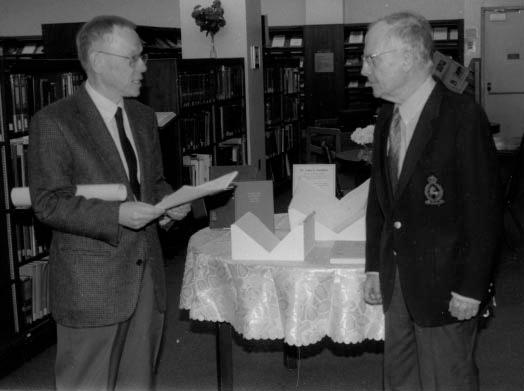
The White Coat Ceremony,a tradition from medical schools and first introduced in 2001 at Penn Veterinary Medicine,was held for the Class of2004 in Houston Hall on December 10, 2002.A Penn landmark,Houston Hall was the nation’s first student union,and it was recently
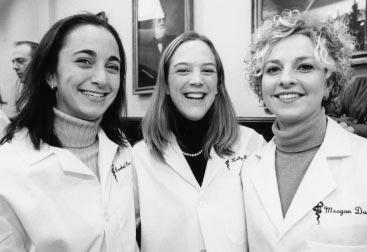
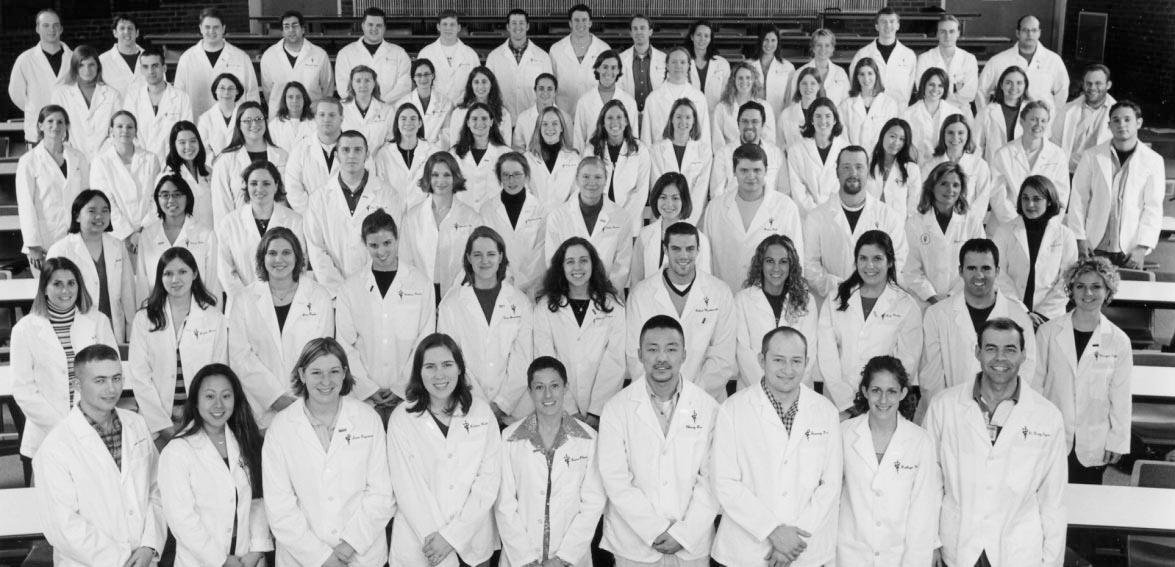
renovated to continue to serve students. Many relatives and guests ofthe students attended the ceremony and the reception that followed.The ceremony marks the end ofthe students’training in the classroom,and the beginning oftheir clinical rotations where they
Because ofan editing error,the complete caption was not published for this photo from the 2002 Rush Shippen Huidekoper Society Dinner,published in the winter 2002 issue of Bellwether.The photo with the complete caption is below.
will apply the knowledge they have learned during the first two-and-a half-years oftheir four-year veterinary education.
Speakers included faculty members, Karen O’Connor,V’04,class president, John I.Enck, Jr.,V’70,president ofthe Pennsylvania Veterinary Medical Association and the state veterinarian for Pennsylvania,and Christine Bohn, V’02,who spoke on behalfofthe School’s Veterinary Medical Alumni Society. Russell E. Angstadt,V’76,spoke on “The Family:Sharing Commitment.”His daughter,Ellen,is a member ofthe Class of2004.
Sponsors ofthe ceremony included the Pennsylvania Veterinary Medical Association and the Suburban Veterinary Medical Association.The Veterinary Medical Alumni Society gave the students Penn brass pins to wear on their white coats.
Class of 2006 Opportunity Scholarship Recipients and Donors/Mentors:
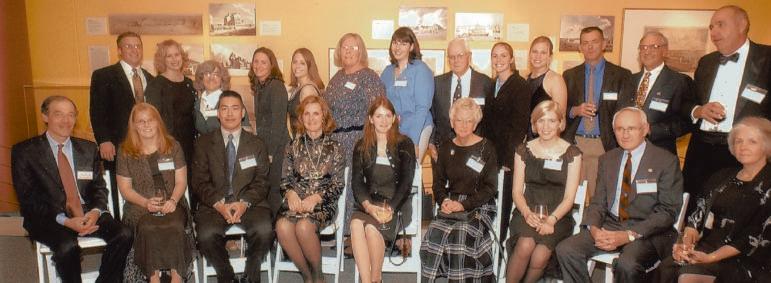
Standing: Patrick J.Ford,V’06,Michelle H.Patrick,V’06,Marilyn B.Weber,V’75,Leslie C. McLaughlin,V’06,Kristina N.Willoughby,V’06,Midge Leitch,V’73,Christin L.Veeder,V’06, Charles W.Raker,C’41 V’42,Lauren M.Greene,V’06,Nadine A.Salomon,V’06,Dean W. Richardson,James V.Stewart,V’68,and William J.Solomon,V’68.
Seated: Andrew H.Elser,V’87,Kari Lyon,V’06,Alexander M.Chan,V’06,Brenda Lewis Stewart, V’70,Amanda L.Lang,V’06,Sandy K.Koenig,Christie L.Schroth,V’06,Charles W.Koenig,V’57, and Jill Beech,V’72.
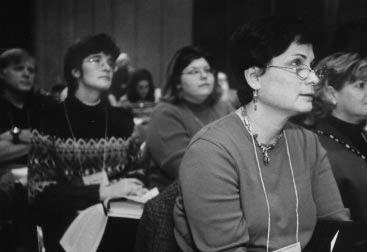
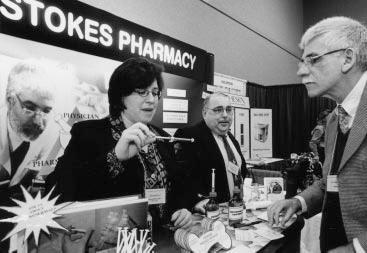
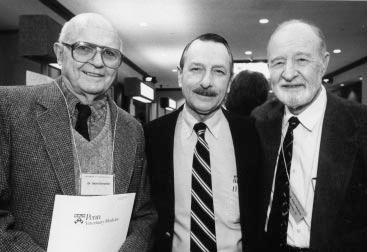

Not even a snowstorm could prevent the country’s oldest continuing education conference for veterinarians and veterinary technicians,the 103rd Penn Annual Conference,held on January 29-30,2003,at the Adam’s Mark Hotel in Philadelphia,from attracting 650 veterinarians and 160 veterinary technicians.In addition,more than 375 ofthe School’s faculty, staff,and fourth-year students attended.
Internationally recognized speakers addressed a wide range oftopics to veterinarians in the Companion Animal,Equine,and Food Animal sessions.Some ofthe areas covered this year in the companion animal medicine seminars included immunology,diabetes mellitus,reproduction,dermatology,and avian and reptile critical care.Large animal practitioners chose from several topics that included equine conditions ofthe small intestine causing colic,agroterrorism,and field application of CPM-Dairy.Companion animal technicians had a specialized two-day seminar that covered systemic inflammatory response syndrome, drug-nutrient interactions in enterally fed patients,and preanesthesia nursing management.Many sessions were standing room only.
The first day concluded with a well-attended Dean’s Reception hosted by Dean Alan Kelly.
New Bolton Center’s radiology suite has a new look.Instead ofprominent view boxes there are large computer monitors.In the big room where the radiographs are taken,a small cabinet with a computer on top sits to the side.It contains a rectangular piece,9 by 11 inches,that is tethered to the computer.This flat-panel digital detector replaces the traditional film.The new equipment was made possible by a $500,000 bequest from the Estate ofElizabeth Ernst Fosbinder,wife of the late Dr.Russell J.Fosbinder.
When an animal is x-rayed,the detector is placed where the film cassette would have been, the head ofthe x-ray equipment is positioned and then turned on.The detector generates the image from the radiation received.The image is transmitted to the computer where it is stored. It can be viewed almost instantaneously (within about 3.5 seconds).There is no more waiting for the film to be developed,no more clustering around view boxes,as the image can be called up on any computer in the radiology suite and by any clinician in an office.
Images are stored on a special secure server
and are backed up automatically.Students are trained in the interpretation ofdigital radiographs as well as traditional films.This new equipment expands diagnostic and teaching modalities at New Bolton.
“The DR system is particularly useful for assuring that the positioning ofa radiograph is appropriate.It has greatly reduced the number oftimes horses need to be re-sedated ifa view might need to be repeated.Digital radiographs are also rarely overexposed or underexposed which also largely eliminates the need to repeat views.The ability to review radiographs immediately by double clicking on a name rather than pulling numerous films out ofa folder has been wonderful,”says Dr.Alexia McKnight, lecturer in radiology at New Bolton Center.
At this time,the detector is only large enough for imaging oflimbs.Radiologists are hoping to acquire a larger detector so that digital radiographs can be taken ofskulls and other large body parts,but this equipment is extremely expensive and such a plate,at this time,is not yet available.
Huidekoper Society Breakfast and a Pacesetter and Class Agent Luncheon.
The Conference gratefully acknowledged the financial support ofeducational program sponsors,DVM Pharmaceuticals,Hill's,Iams,Nestlé Purina,and Schering-Plough.The School also sincerely thanked the patron exhibitors and standard exhibitors who financially supported the Conference by selling out the main exhibit hall and a newly-added second exhibit hall that accommodated a waiting list ofexhibitors.
The 104th Penn Annual Conference is scheduled for March 11-12,2004 at the Adam’s Mark Hotel in Philadelphia. Please bookmark the web site, <http://alumni.vet.upenn.edu/ pennannualconference.htm>,and check your mail in the winter for the 2004 Penn Annual Conference brochure.
He owns a wildly-successful veterinary practice,one ofthe largest privately-owned ones in the country.But Anthony J.DeCarlo,V’82,is hardly complacent.
“I wake up every morning and tell myselfI have the worst hospital in the country,”says DeCarlo,who,with partner and classmate Thomas S.Trotter,V’82,owns and operates Red Bank Veterinary Hospital,a specialty referral practice in Red Bank,N.J.
This DeCarlo-brand pep talk,he says,spurs him to make constant improvements in his hospital.Like novel medical protocols, better equipment,a new 58,000-square-foot building complete with a 150seat lecture hall,2,400square-foot pharmacy, fitness room and daycare facility that they will relocate to next year,plus staff education initiatives and fresh hires.For example,DeCarlo recently augmented his staffof 180 with client-service coordinators,whose chieffunction is to flit about the waiting room, where they modulate the traffic flow,provide updates to owners,and dole out coffee and conversation.
He also leans on his employees to act as change agents:“I tell my staff,‘Every time you go to the dentist’s office or grocery store,take all the things you like and practice them here.’”
DeCarlo has banished phrases like “We’re too busy,”“I don’t know,”“We don’t do that” and “That’s not our policy.”
An admitted meeting fiend,he participates in most staffbrainstorming sessions.At his regular management meetings,he keeps the focus on serving the patients and their owners.While he allows his supervisors plenty ofleeway in making decisions,each oftheir proposed initiatives has to satisfy DeCarlo’s do-or-die question:“How does that make it better for the client?”
He eschews many practices that predominate today in veterinary medicine,such as ordering automatic complete blood counts on every pet over six years ofage,charging for euthanasias, and overvaccinating.Red Bank began offering vaccine titers five years ago in order to eliminate
 by Joan Capuzzi Giresi,C’86 V’98
by Joan Capuzzi Giresi,C’86 V’98
unnecessary vaccination,and discourages the use ofvaccines that are ancillary or ofquestionable safety/efficacy.He says his clients are often delightfully surprised that products and services are not being pushed on them.
In an effort to stay as recession-proofas possible,Red Bank offers neither boarding nor grooming,and tenders little in the way ofpet products.DeCarlo,who laments that “veterinarians try to make money today and not 10 years from now,” has opted for a more clientcentered and long-sighted operations strategy. For example,he stayed the course with his evening emergency service,even though it incurred losses in its first six years.Ultimately, it produced net gains by bolstering the daytime business and providing the 24-hour service his clients desired.
DeCarlo,who has never taken a business course and does not use practice consultants, netted much ofhis business acumen as an adolescent in his family’s printing business.Born in Passaic,N.J.,he grew up just minutes from the George Washington Bridge.His lower-income family found financial stability in the printing company his father started when young Tony was in grade school.He worked there during his school years,learning about sales and negotiations,employee issues and union dealings.
DeCarlo began college as a philosophy major,but floundered academically.Unsure of his career interests and feeling pressure to eventually take over the family business,he sought counsel from a friend.She suggested that he set out to do that which he liked reading about;at work, he often picked up books about medicine and animals.So he began volunteering at Oradell Animal Hospital in Oradell,N.J.,and set his sights on veterinary medicine,which also held for him the allure ofa challenge.After several false starts,he graduated a biology major from Ramapo College ofNew Jersey in Mahwah,N.J.,at the age of25.
With persistence,DeCarlo beat the odds –12:1 at the time – and eventually was accepted to Penn’s veterinary school,where he served as class president for four years and student gov-
ernment president for two.After graduation,he completed an internship at Oradell,and returned to Penn to do a residency in neurology.He had become enamored ofthe specialty, he says,because it allows “a lot ofroom for thinking,and everything is not always black and white.”
And neither is starting a veterinary hospital. Shortly after finishing his residency,DeCarlo returned to New Jersey,where,by pure serendipity,he ran into former classmate Trotter. The two set out to open a practice together. After some creative cajoling,DeCarlo was able to convince a bank to provide 100 percent financing for their hospital,which began offering 24/7 service out ofa tiny,dilapidated building.That was 17 years ago.
Today,after almost two decades of25 percent average annual growth,Red Bank grosses over $15 million a year.This ranks it in the top twenty largest veterinary practices nationwide. The hospital’s 35,000 active clients,not including referrals – the bulk ofits business,are scattered across a portly circumference that stretches from upstate New York to Virginia, east-central Pennsylvania to the Atlantic Ocean. Red Bank employs nearly 40 veterinarians –two thirds ofwhom are specialists in neurology,oncology,ophthalmology,internal medicine,dermatology,cardiology and orthopedics – and has internship and residency programs.
Due to his successful career,DeCarlo was invited to share his professional experiences and advice with current veterinary students at Penn as part ofthe Dean’s Alumni Career Speaker Series this past January.According to Dean Alan M.Kelly,DeCarlo helped to “educate students on the opportunities and challenges facing them after they graduate.”When he hires recent graduates,DeCarlo,who stopped seeing patients two years ago to focus on the growing demands ofrunning the business operations,seeks those who “know how to intellectually approach a case.”He adds:“I don’t care ifthey know how to do a spay.”
DeCarlo,52,acknowledges he has hit on a winning business formula.However,he hopes that the inevitable growth can be maintained at a steady rate.He says his biggest challenge is to run a mega-practice with the intimacy ofa twoperson shop.He relies heavily on his employees to supply the personal touch to his clientele.
(continued on page 21)

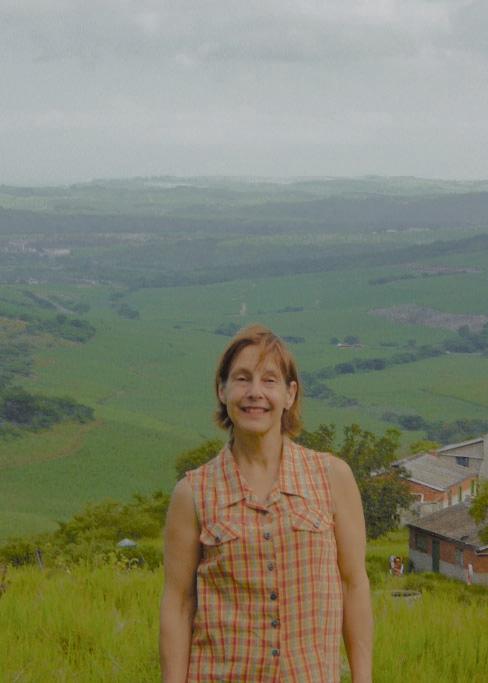
If Timbuktu,the city in the West African nation ofMali,sounds remote from Philadelphia,Mandeni,Zululand on the east coast of South Africa is even further.That’s where I’ve been living and working in a rural mixed practice with my husband,Peter,since 1975 when we settled on Cranburn,his family’s sugarcane and cattle farm.I met Peter,a native South African,when he served as an intern and resident in bovine medicine and surgery at New Bolton Center from 1972-74.Sometimes,in an introspective moment,I shake my head,as if awakening from a dream and ask,“What am I doing here in Zululand ofall places?”
A second generation American,I was steeped in the ethos ofdemocracy,human rights and patriotism.In 1969,I graduated from Vassar College in my hometown ofPoughkeepsie,N.Y.,with a B.A in biology and English.I had never desired to travel,so when my IBM engineer father asked ifI’d like a trip overseas as a graduation present, my reply was,“No thank you, Dad.Someday I’ll travel,but there’ll be a good reason for it.” The good reason arrived when I met Peter and was swept not only offmy feet but also out ofmy country.
Peter proposed to me in a letter listing all the things I would find hard to adjust to in his country. He didn’t want his American bride ignorant ofthe downsides ofliving in remotest Africa with later regrets.Before saying yes,I had to visit Peter’s farm and family.The farm was breathtakingly beautiful,his family truly fantastic.I liked what I saw;I was young,immortal,invincible and very deeply in love.I said,“Yes,” and promptly went to bed for two weeks with Rift Valley Fever from a calfpost mortem.
A kaleidoscope ofimpressions from those early days swirls before me.Everything was so different – apartheid,no TV,antiquated telephones,an oppressive government and driving on the wrong side ofthe road.The Afrikaans accent was hard to understand but the Natal English accent was music to
by Margaret Hiza Ardington,V’73anglophile ears.I taught myselfZulu out ofa book,practicing it with James,our Zulu domestic worker,a man ofgreat character, whose eye was stabbed out in a drunken brawl. This country ofmarked contrasts had delightfully wild places, wild animals and wild people.It was an amazing time living through Mandela’s release, the end of apartheid and the start ofa new democracy.
The differences extend to veterinary medicine but
ehrlichiosis,anaplasmosis and heartwater.We have been bitten by rabid cats and dogs and gone through the series ofinjections and the long wait to see ifthe slow virus wins.I absolutely hate African horse sickness;it makes us feel so helpless watching our patients drown in their lung edema.Then there are the wild animals brought in to us – exquisitely beautiful gray duikers;quaint, sprightly bushpiglets; snakes and magnificent birds usually with broken wings for setting.Poaching with snares is practiced heavily so we see dreadful snare wounds in dogs. Bushpigs often leave dogs gutted by their razor sharp tusks.
It is interesting to note cultural differences in attitudes towards animals in our rainbow nation. Hindu clients religiously oppose euthanasia, even ifit’s the obvious humane answer.Zulu clients treat dogs as lowly creatures,while they revere their cattle as symbols ofwealth,using them traditionally for lobola,a type ofdowry. A Zulu client might walk for miles to come to us,dressed in rags with very little money,but another might arrive in a Mercedes.Ours is a practice that runs the gamut from First to Third World clientele daily.
In South Africa,our profession is composed of2,500 registered veterinarians with a high level ofpractice,good camaraderie and excellent continuing education,frequently boosted by speakers from the United States.Peter served on the South Africa Veterinary Council for 18 years,and was president during the transition phase into the new South Africa.I believe our profession was very lucky to have a man ofhis caliber leading us.My contribution was to advise him and run the practice while he was away.
I married a good teacher who was top ofhis graduating class.Many ofthe subtropical cocktail ofAfrican diseases that we as students just flipped past in our texts were coming through our hospital doors or seen in our fieldwork –tick borne diseases such as babesiosis,
Bucking the white emigration trend,my parents came to live here.Vivacious and active, my 88-year old mother and our lovely daughters,Julia,24,and Jacqui,22,enrich our lives. And the answer to my question,“What am I doing here in Zululand?,”is I’m living a dream and loving it!

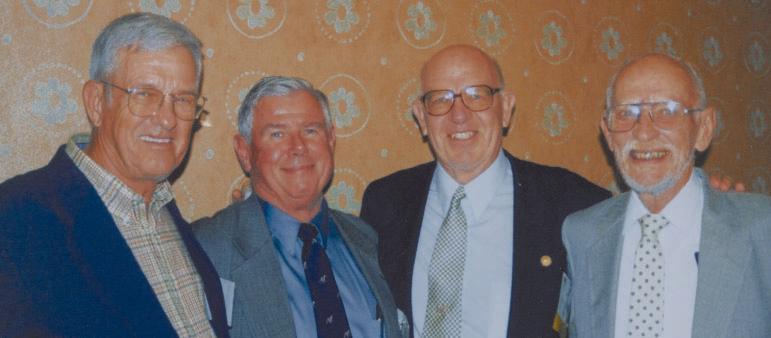
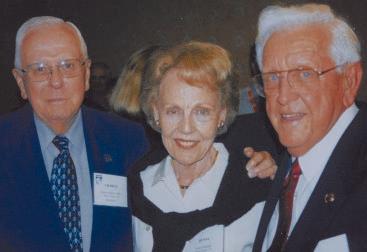

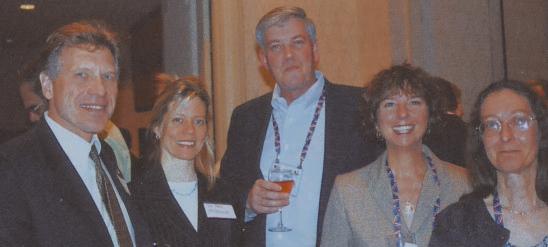

More than 75 School ofVeterinary Medicine alumni and their guests attended an alumni reception during the American Association ofEquine Practitioners Annual Convention in Orlando on December 5,2002.Penn alumni enjoyed the opportunity to renew old friendships and make new ones during the premier equine veterinary continuing education event in the world.In addition to Dean Alan M.Kelly giving alumni an update on recent activities at their alma mater,attendees viewed On Any Given Day on a large screen to celebrate New Bolton Center’s 50 years ofveterinary excellence.The new 15-minute video follows a day in the life ofNew Bolton Center.

One ofthe best-attended alumni receptions in recent memory was held at the North American Veterinary Conference in Orlando on January 19,2003.Although the temperature outside was unusually cold and the Philadelphia Eagles had lost the NFC Championship earlier in the day to the eventual Super Bowl Champions,Tampa Bay Buccaneers, everyone’s spirits were high.Penn Veterinary Medicine alumni and their guests took advantage ofthe opportunity to catch up with one another and with members ofthe School administration and faculty.

President Bush delivered his much-awaited State ofthe Union Address on January 28,2003. That day the streets ofCapitol Hill and the halls ofCongress were flooded with thousands drawn to the epicenter ofAmerican power – although only a privileged few were lucky enough to occupy one ofthe precious seats in the packed gallery. Most ofthese visitors wash in and out oftown quickly like the tide.The following evening,I was able to sit alone in the galleries ofthe Senate and House and watch the proceedings on the floor below.That’s how it goes in the nation’s capital.
Last year I successfully applied for a Congressional Science Fellowship,which is sponsored by the American Veterinary Medical Association (AVMA) and the American Veterinary Medical Foundation (AVMF).Congressional Science Fellows serve for one-year in Washington,D.C.,as representatives of the veterinary profession on the staffs ofMembers ofCongress or Congressional Committees.
The morning ofJanuary 28,I took my usual route past the Hart Senate Building (site ofthe mailed anthrax contamination),the Supreme Court and the Library ofCongress to my office in the Cannon House Office Building,which is adjacent to the Capitol.After checking the congressman’s schedule,my morning activities included answering email and returning phone messages. Two other legislative assistants (LA’s) and I were to have a meeting that afternoon with our “Boss” (the traditional term used by staffers for their representative) to discuss upcoming legislative issues.
My “Boss”is John E.Peterson who represents Pennsylvania’s Fifth Congressional District.It is the largest rural district east ofthe Mississippi River encompassing all or part of17 counties in north central and northwestern Pennsylvania. Within in its borders are Pennsylvania State University,the Allegheny National Forest,and a multitude offar-flung rural communities.
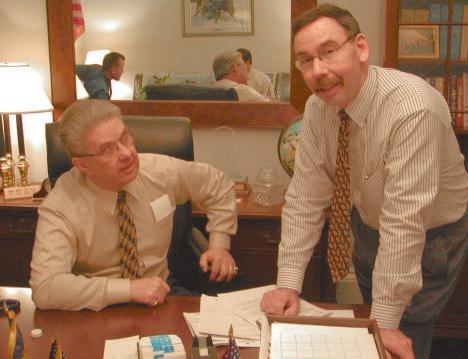
Representative Peterson has strong interests in representing rural America and is a member of the Congressional Rural Caucus.He is a member ofthe Appropriations Committee,arguably the most powerful House committee,where he serves on the Energy and Water Development,Interior, and the Labor,Health and Human Services,and Education subcommittees.The congressman is also a member ofthe Resources Committee, where he serves on the National Parks,Recreation,and Public Lands and the Forests and Forest Health subcommittees because the Allegheny National Forest is in his district.
by Raymond W.Stock,V’75Members ofthe Appropriations Committee have the privilege and power to determine federal expenditures.This makes them sought after by the thousands ofprivate citizens and professional government relations’representatives who bring their lobbying efforts to Washington.One ofmy jobs is to help the congressman by meeting with many ofthe lobbyists.
My morning was spent writing short memos to Peterson concerning the various “Dear Colleagues”letters that cross my desk daily.Other members ofCongress generally send them requesting support in co-sponsoring bills or signing onto letters requesting actions directed to the President, department secretaries,or agency directors.Many ofthese include bills that never passed out of committee in last year’s 107th Congress and have to be reintroduced in the 108th.A computer search ofinformation from the Legislative Information Service or the Congressional Research Service helps get me up to speed quickly on the essential elements ofthe bills.
Early in the afternoon,I used the legislative drafting service ofthe House Legislative Counsel’s office in an effort to remedy a problem concerning counties both in Pennsylvania and nationwide who failed to qualify for the Livestock Compensation Program.This monetary compensation program for livestock and dairy producers was designed to provide relieffor forage crop failures during the preceding summer’s drought.
Many deserving counties in the country, including one in my district that represents a thousand dairy farmers,failed to qualify for the program due to a number ofadministrative reasons.Our job was to remedy the problem by legislation.An attorney in the Counsel’s office converted my explanation into the language we needed within the hour.The additional pressure ofother representatives and senators representing agricultural areas resulted in $3.1 billion appropriated for drought reliefin the FY 2003
Omnibus Appropriations bill signed into law by President Bush in February 2003.
Later that afternoon,the two other LA’s and I met with Peterson to discuss our specific areas of responsibility.Mine include agriculture,telecommunications,immigration,welfare,science and technology,veterans and welfare.Bills are presented to the congressman,discussed and courses of action decided upon (i.e.,to co-sponsor or support).When the appropriations cycle for FY 2004 gets into high gear in March,the workload of issues will accelerate dramatically.
I left the office around 7:00 p.m. Security surrounding the Capitol had elevated dramatically during the afternoon in anticipation of the entire corpus ofthe legislative, executive and judicial branches congregating within the Capitol’s chambers.Security extended for a distance offive to six blocks from the Capitol grounds with busses and fire trucks serving as barriers across all ofthe surrounding streets.
Mounted police,scores ofmotorcycle officers, hundreds ofCapitol Police,local police departments and state troopers from Maryland and Virginia were all present.The chopping sound ofthe overhead helicopters in concert with the glare of high intensity lighting and the flashing lights of hundreds ofpolice vehicles created a surreal atmosphere.I retreated from this unsettling environment to the comfort ofmy tiny apartment to watch the President’s annual address to Congress.
Prior to his fellowship,Dr.Stock practiced small animal medicine in the Lehigh Valley for over 25 years.He has been active in veterinary medicine organizations throughout his career,and is a member ofthe University ofPennsylvania Veterinary Medical Alumni Society Executive Board and a trustee ofthe Pennsylvania Veterinary Medical Association.Dr.Stock recently received a Master ofBioethics degree from Penn.
Editor’s Note: Along with Dr.Stock,Richard A.Zappala II, V ’97,was also selected as a Congressional Science Fellow,and is serving in the office ofRepresentative Howard L.Berman,who represents California’s 28th Congressional District (Los Angeles County).
For more information on the Congressional Science Fellowship program,visit the AVMF web site at <www.avmf.org>.
Josephine Deubler received the American Kennel Club Lifetime Achievement Award for Conformation during a ceremony in New York City in February 2003.The AKC presents the Lifetime Achievement Awards annually to recipients,who have been selected by members ofthe dog fancy,in recognition of their many years ofselfless efforts that have significantly contributed to the sport on a national level.
1948
During the Pennsylvania Veterinary Medical Association’s 120th Annual Scientific Meeting in August 2002, Richard H.Detwiler was honored with the Lifetime Achievement Award in recognition and appreciation ofhis many years ofdedicated service to the PVMA as AVMA delegate and as a member of the Executive Committee.
1950
T. Richard Houpt was honored with life membership in the Conference ofResearch Workers in Animal Diseases during its annual meeting in November 2002.
David A.Meirs II was interviewed by The New York Times on February 23,2003,in an article about the state ofthe horse industry in New Jersey.According to Dr.Meirs,who raises Standardbred horses on his farm,“Buyers are going to say,‘To hell with the stock market,I did better with my racing stables last year.’Ofcourse,it’s more fun to go to the races than to watch your stocks every day.”
Lawrence E.Atkinson was profiled by the Christian Science Monitor on December 20,2002.According to the article,Dr.Atkinson,a veterinarian at Laurel Park in Laurel,Md.,“is arguably the strongest person his age in America.”He started weight lifting at age 75,and says he holds state and national records in bench press,curling,and a combination event of dead lift and bench press.He has cared for Seattle Slew and War Emblem,and has worked the Preakness Stakes six times.To read the full profile online,visit <www.csmonitor.com/2002/1220/ p10s01-alsp.html>.
Arthur A.Bickford received the Lifetime Membership Award from the American Association of Veterinary Laboratory Diagnosticians during its annual conference in October 2002.Dr.Bickford was also honored with life membership in the Confer-
ence ofResearch Workers in Animal Diseases during its annual meeting in November 2002.
Peter Theran,vice president ofthe Health and Hospital Division for the Massachusetts Society for the Prevention ofCruelty to Animals/American Humane Education Society,was honored in April 2003 with the Massachusetts Veterinary Medical Association’s 2002 Distinguished Service Award.The award,the most prestigious award that the MVMA confers,is given for accomplishments in the MVMA and in veterinary medicine and who has made an outstanding contribution to the service ofhumankind. With his experience in laboratory animal medicine, Dr.Theran has helped shape standards and practices that address research needs while respecting animal welfare concerns.
During the PVMA’s 120th Annual Scientific Meeting in August 2002, Joseph R.Raught was honored with the Public Service Award ofMerit for his continuous contributions to local and global communities over the past two decades through his work with Heifer Project International and for setting a shining example ofvolunteerism.
Daniel H.Rice III was named Hartz Veterinarian ofthe Year in 2001.Owner ofHolden Veterinary Clinic in Holden,Mass.since 1969,Dr.Rice was nominated by Holden Animal Control Officer Anjie Coates.In her nomination ofDr.Rice,Coates wrote, “His gentle voice and soft touch calm the most frightened animals,and they know that he is the only one who can,and sometimes the only one who will, help them fight for their lives.”According to Dr.Rice, “I’ve always enjoyed veterinary medicine,mainly because it’s challenging and it’s something different all the time.I’m never going to retire.I don’t think there’s a lot ofpeople who can get up after 40 years and still say ‘I enjoy my work.’”
Donald R.Shields and his wife,Donna,were profiled in The Philadelphia Inquirer Magazine on April 6,2003,for their volunteer work with the Feral Cat Committee,a group ofcat rescue people in the Philadelphia region who have organized to address the needs offeral cats.According to Mrs.Shields,‘It’s a shame,the thousands oflovely animals that are euthanized because humans don't care enough to take proper care ofthem.”Dr.Shields owns Bethayres Veterinary Hospital in Huntingdon Valley, Pa.For information about the Feral Cat Committee, visit <www.savephillycats.org>.
Ronald L.Genovese was one oftwo veterinarians honored with the Distinguished Educator Award from the American Association ofEquine Practitioners during its 48th Annual Convention in December 2002.He was recognized for his significant impact on the development and training ofequine practitioners. Dr.Genovese,president ofRandall Veterinary Hospital in Warrensville Heights,Ohio,has helped countless young veterinarians learn the rigors ofprivate equine practice,and since 1983 has provided one-on-one assistance in ultrasonography to well over 50 veterinarians in his clinic.When nominated for this award, he was described as a man revered by his clients, respected by his colleagues and loved by his staff.
The late Howard S.Kessler was honored posthumously as one offive new veterinarians to be inducted into the Morris Animal Foundation’s Veterinary Honor Roll.Ms.Karen LaFrak contributed $500 or more to the Foundation to nominate Dr.Kessler. “These veterinarians have gone beyond their duty to provide outstanding veterinary care to their patients,” said Dr.Robert Hilsenroth,executive director of Morris Animal Foundation.Dr.Kessler practiced in New York City.
William J.Solomon was profiled in The BloodHorse on March 22,2003,on the occasion ofhis Thoroughbred and Standardbred farm’s 30th anniversary.The 400-acre Pin Oak Lane Farm,near New Freedom,Pa.,foaled the only Pennsylvania-bred winner ofthe Kentucky Derby,Lil.E.Tee in 1992.Dr. Solomon no longer practices outside the farm,which will foal about 100 mares this foaling season.
1970
Fantaw Makonnen is the Opportunities Industrialization Centers International,Inc.(OICI) Country Representative in Ethiopia.Founded by the late Reverend Dr.Leon H.Sullivan,OICI is a non-profit private voluntary organization devoted to improving the lives ofthe underprivileged in developing countries.
During the American Association ofEquine Practitioners’48th Annual Convention in December 2002, Scott E.Palmer was installed as vice president ofthe AAEP.Dr.Palmer is president and a staffsurgeon at the New Jersey Equine Clinic in Clarksburg,N.J.
1981
Jonathan H.Leach was profiled in The Falmouth Enterprise on April 4,2003,on the occasion ofopen-
ing a new hospital,Leach Animal Hospital,on Cape Cod in Mashpee,Mass.According to the article,Dr. Leach’s father was Cape Cod’s first licensed veterinarian,and his uncle was the second veterinarian on the Cape.A mixed animal practitioner,Dr.Leach also makes field calls to local stables and farms.
1982
Julia A.Langenberg is secretary ofthe American Association ofZoo Veterinarians.
1983
Steven J.Berkowitz took first place in The Horse ofDelaware Valley’s 12th annual Photo Best Action Division.Dr.Berkowitz also took third place in the division as well as first in Candids and third in Pets. The Horse ofDelaware Valley is the oldest and largest equine monthly serving Pennsylvania,New Jersey, Delaware,Maryland,and Virginia.
1985
Michael R.Petranto was also one offive new veterinarians to be inducted into the Morris Animal Foundation’s Veterinary Honor Roll.Ms.Diane G. Travis nominated Dr.Petranto in honor ofhis excellent care.“Morris Animal Foundation is honored to recognize these individuals who have earned the utmost respect from their clients,”said Dr.Robert Hilsenroth,executive director.Dr.Petranto practices at VCA Twin Rivers Animal Hospital in East Windsor,N.J.
1986
Linda S.Mansfield has been elected vice president ofthe American Association ofVeterinary Parasitologists for 2003 and will serve as president in 2004.Dr. Mansfield also serves as co-editor-in-chieffor the Americas and Japan for Veterinary Parasitology
Peter C.Rakestraw, assistant professor in the Department ofLarge Animal Medicine & Surgery at Texas A&M University,was recently named a Montague Center for Teaching Excellence Scholar.Dr. Rakestraw received a grant to research and develop innovative teaching techniques.The center’s objective is to stimulate the development ofinnovative teaching strategies and technologies at Texas A&M University and to recognize excellence in teaching early in a faculty member’s career.
Amy Iris Attas was profiled in The New York Observer on January 6,2003.Dr.Attas owns CityPets, New York City’s largest house-call veterinary practice.Her 2,500 clients include many celebrities,Erica Jong,Joan Rivers,and Tommy Tune to name just a
few.According to Dr.Attas,“My favorite part ofthe day is when I’ve just finished sticking needles in a dog and doing all these things that have to be absolutely miserable for them,and I get a big wet kiss across my face.”
Gary E. Rothman was profiled in The Post-Standard ofSyracuse,N.Y.,on January 9,2003.Dr.Rothman recently expanded his practice,Quarryside Animal Hospital in Jamesville,N.Y.,by moving to a new location.According to Dr.Rothman,“We at least tripled the space.We can offer a lot more services.We’re growing fast,and we have better exposure.”An avid photographer,his work hangs in the examination rooms.
Joanna M.Bassert,professor and director ofVeterinary Technology at Manor College in Jenkintown,Pa., was recently named chair ofthe National Commission on Veterinary Economic Issues’StaffUtilization Committee.The committee will help to create interactive online tools that will assist practitioners to more effectively use their support staff.She is the editor ofthe Clinical Textbook for Veterinary Technicians and author of Clinical Anatomy and Physiology for Veterinary Technicians.In addition,Dr.Bassert is the founder ofthe Northeast Veterinary Technician Educators Association.
Celeste C.Kunz has been named ChiefExamining Veterinarian for the New York Racing Association,a private,non-profit racing association that owns and operates the three largest racetracks in New York –Aqueduct,Belmont Park,and Saratoga.Dr.Kunz, who has worked as a track veterinarian for the NYRA since 1994,is the first woman to hold the position. She has been credited for playing a key role in saving the life ofCharismatic,the 1999 Kentucky Derby and Preakness States winner,when he broke his leg during his pursuit ofthe Triple Crown in that year's Belmont Stakes.In July 2002,she spoke on “West Nile Virus:The Emergence ofa New Disease in the Western Hemisphere”at the 14th International Conference ofRacing Analysts and Veterinarians.
Paul R.Avery is a new diplomate ofthe American College ofVeterinary Pathologists and is certified as a veterinary clinical pathologist.
Diane Monsein Levitan recently opened the Center for Specialized Veterinary Care in Westbury,N.Y. It is the first veterinary hospital in the world that provides pet owners with private rooms,enabling them
to stay with their pets during the animal's hospitalization – even overnight.The referral practice also offers 24-hour emergency service,radiation therapy,animal rehabilitation,and radioiodine treatment.
William P.Rives visited the School ofVeterinary Medicine and spoke to students in March 2003 as part ofthe Dean’s Alumni Career Speaker Series.Dr. Rives is the veterinarian at Six Flags Wild Safari in Ocean County,N.J.,which features 1,200 animals representing 52 exotic species.
Heidi B.Stout, director ofoil programs for TriState Bird Rescue & Research ofNewark,Del.,was interviewed on Philadelphia’s KYW NewsRadio 1060 before she left in December 2002 for three-weeks to help save birds affected by an oil tanker spill offthe northwestern coast ofSpain.
Susan V.Westmoreland is a new diplomate of the American College ofVeterinary Pathologists and is certified as a veterinary anatomic pathologist.
Bradford G.Bentz sent this class note via e-mail:“While I was attending a recent scientific meeting,I learned that a very dear friend ofmine had died a number ofmonths ago.Peyton Jones, D.V.M.,although never a ‘Penn-we’,had completed a residency in large animal internal medicine at New Bolton Center in 1994.I was shocked and very upset to hear ofhis death.It was not until only recently that I could objectively reflect upon his impact on my veterinary career and me.
“Peyton was one year ahead ofme in his residency.Although the name ‘Jones’may imply that he was an ordinary fellow,his friendship,encouragement and tutelage during my residency could not have been any more extraordinary.Peyton warmly embraced a role as my ‘big brother’during his tenure as a resident.I immediately found him to be a warm and genuine person to whom I could always look for encouragement during the times that I could find little reason for optimism.He always encouraged me to dig a bit deeper and to believe in what I had to offer this profession at times when I was unsure that I had much to offer.Indeed,at one point in my residency, when I was seriously considering leaving the program,Peyton only found promise and genuine concern for me and for my future in his heart.I truly believe that it was his encouragement and his belief in me that kept me going when I felt I could not.
“Today,I am very happy with who I am,what I am doing and how I am contributing to this profession. Peyton has much to do with my success.In my final words to you,Peyton,‘thank-you.’You were anything
but an ordinary person in my life.May you find much-deserved peace and happiness in your rest.God bless you.”
Christine Kreuder,a graduate student in wildlife epidemiology at the University ofCalifornia,Davis, was recently named a Morris Animal Foundation Fellow.The Foundation established the Fellows program in 1955 to honor students who participate on the investigative teams ofFoundation-funded animal health studies.Fellows are nominated by the principal investigator ofthe study on which they are working. In addition to Dr.Kreuder’s main research topic of infectious disease ofmarine mammals,her research interests also include population-level impacts ofdisease in wildlife,disease ecology,and measures ofpopulation abundance.
1995
Alexander J.Travis was recently appointed an assistant professor at the James A.Baker Institute for Animal Health ofthe Cornell University College ofVeterinary Medicine.A reproductive biologist,Dr.Travis’ research interests include the compartmentalization of metabolic and signaling pathways in male germ cells, germ cell differentiation,and the development ofin vitro spermatogenesis.His clinical interests include assisted reproductive technologies in exotic and domestic species and conservation and preservation of genomic diversity in wildlife.
Amanda E.Fine is one oftwo Michigan State University scientists heading up a new graduate specialization program in wildlife disease ecology and management.Dr.Fine is currently conducting research on the epidemiology ofbovine TB in Michigan with a focus on the interaction between cattle and white-tailed deer and the identification ofrisk factors for disease transmission.Her additional research interests include the epidemiology ofwildlife-livestock disease transmission,veterinary public health and international veterinary medicine.
1998
S arah Anna Pesillo is a new diplomate ofthe American College ofVeterinary Emergency and Critical Care.
1999
Akiko Sato has completed her residency in laboratory animal medicine at the UCLA David Geffen School ofMedicine.Dr.Sato has recently joined the VA Greater Los Angeles Healthcare System,the
largest,most complex healthcare system within the U.S.Department ofVeterans Affairs,as an associate veterinary medical officer.
2001
Jonathan M.Castro has recently joined the Banfield Durham,North practice in Durham,N.C.
Eric D.Lombardini,a captain in the United States Army Veterinary Corps at Fort Polk,La.,is currently serving in Operation Iraqi Freedom.Dr.Lombardini served as an expert for The Worst-Case Scenario Survival Handbook: Holidays.Dr. Lombardini is a 1993 Penn undergraduate and a classmate ofJoshua Piven, a co-author ofthe book.
2002
Amy L.Hancock is a clinical veterinarian at the Center for Animal Resources and Comparative Medicine at Harvard Medical School.
1998
Barbra Hart-Karner,a son,Joshua Lewis,on May 11,2002.
2001
Stephanie R.Becker,a daughter,Erin Lee,on November 6,2002.
1937
J.Robert Brown on September 4,2002. Benjamin F.Stearn on August 23,2002. Douglas F.Watson on February 11,2003.
1938
Morris Cover on January 28,2003.
1943
C.Arnold Moorehead on March 27,2003.
1944
Winthrop Eugene Brielman on March 8,2003. Brother ofMarguerite Brielman Gulick,V’44.
1946
Col.Martin S.Oster on May 31,2002
1949
Jane Hinton on April 9,2003.
1951
Raymond E.McKinley on February 6,2003.
1953
James F.Basque on September 26,2001.
1954
Ralph B.Jackson on April 6,2002.
Craig M.Kift on August 6,2002.
Melvin E.Vaclavik on March 26,2003.
1955
Irving I.Lutsky on November 16,2002.
1956
Warren R.Piersol on March 5,2003.
1958
Gaylord E.McKissick on December 15,2002.
1959
Eugene A.Bodmer on May 12,2002.
1963
Jeffie F.Roszel on January 13,2003.
1964
Kenneth J.Rubin on March 5,2003.
1968
Norman Frank on December 28,2002.
1969
James A.Craig on October 10,2002.
1985
Janet Remetta on March 31,2003.
1999
David J.Nebzydoski on March 15,2003.Son of Henry J.,V’72;brother ofBeth A.,V’02;nephew of Joseph A.,V’82,Andrew P.,V’84,and Patricia A. Morgan,V’85.
Share news with your classmates about a new position or accomplishment,wedding or birth announcement,by sending your class note today! We accept pictures,too,featuring alumni gatherings,whether it’s from a wedding or mini-reunion.Be sure to identify everyone in the picture.Pictures will be returned only upon request.Send all your submissions to:
Joshua E.Liss
Director ofAlumni Relations and Annual Giving University ofPennsylvania School ofVeterinary Medicine 3800 Spruce Street Philadelphia,PA 19104-6047
Fax (215) 573-3544
E-mail lissj@vet.upenn.edu
(continued from page 14)
His staffhear his favorite mantra – “Attitude reflects leadership”– again and again.“IfI set a good attitude at my level,”explains DeCarlo,an avid motorcycler with a longtime involvement in the Ronald McDonald Camp for children with cancer,located in the Pocono Mountains, “it will filter down to the receptionist and then to the client.”
Head veterinary technician Janet McConnell, who joined Red Bank 10 years ago when it was a five-doctor practice,notes that Red Bank employees rarely leave.She attributes the low turnover to DeCarlo’s ability to connect with the staff.“Out ofthe blue,he’ll say,‘Let’s buy the hospital pizza today.’”
He also hosts frequent staffget-togethers at his home in nearby Ocean Township,N.J., where he lives with his two cats.In addition to investing in his employees’friendship,he invests in their intellect:Each employee,from the veterinarians to the janitors,has a continuing education budget.
As for the future ofhis profession,DeCarlo sees the tides shifting in favor oflarge practices like his own that,because oftheir sheer size, can offer a wider breadth ofservices to their increasingly-demanding clients.
When he appraises his hospital in self-talks each morning,he is downright critical.No matter.As a veterinarian and a practice owner, DeCarlo has arrived.But he’ll never admit it.
To find a former classmate and to sign-up for a permanent e-mail forwarding service: Join the University ofPennsylvania Alumni OnLine Community for free at <www.alumni connections.com/olc/pub/UPN>.After you register, you can search the On-Line Directory,which is a great resource for personal and professional networking and an easy way to keep up-to-date on fellow alumni.You can also sign-up for a permanent e-mail forwarding service,which will forward messages received at your permanent Penn address to the e-mail address ofyour choice.
To update your alumni record:
You can update your record via the University of Pennsylvania Alumni On-Line Community OnLine Directory.You may also contact Elizabeth McNamara at (215) 746-7461 or via e-mail at <emcnamar@vet.upenn.edu>.
To make a gift or for information to support Penn Veterinary Medicine: Make a gift with your credit card through a secure online transaction at <www.upenn.edu/gifts>.For information on supporting the School,visit the Alumni & Friends web site at <http://alumni.vet. upenn.edu> or contact Joshua E.Liss at (215) 898-1481 or via e-mail at <lissj@vet.upenn.edu>.
To request a transcript,certification of graduation, or replacement diploma:
For information on requesting a transcript,visit the Office ofthe University Registrar’s web site at <www.upenn.edu/registrar/trans.html> or call (215) 898-7511.For information on requesting a certification ofgraduation,which does not require a transcript,contact the School’s Office of Student & Curricular Affairs at (215) 898-3525 or via e-mail at <student-affairs@vet.upenn.edu>.
For information on ordering a replacement diploma,visit the Office ofthe Secretary’s web site at <www.upenn.edu/secretary/diplomas/ diplomalist.html>.
To post/search employment opportunities for veterinarians: Visit the School’s Veterinary Employment Database at <www.vet.upenn.edu/jobsearch>.
D. Christine Anderman,V’98, married Jeffrey S.Leigh, C’93 D’97,on September 21,2002,on the banks ofthe Chesapeake Bay near their home in Annapolis,Md. Dr.Leigh practices at Arnold Veterinary Hospital in Arnold,Md.

Back Row: David F.Zeyher,D’61 GD’64,Alan G. Harquail,Jr.,D’54 GD’60,Russell S.Anderman,Jr.,EE’67, Matthew Baron,D’99,Greg E.Dalin,D’97,Jeffrey S.Leigh, Thomas M.Drummond,D’97,Mark J.Robinson,D’97, Brian Duffy,WG’97,and Robert A.Leigh,D’69.
Front Row: Lois Hicks Zeyher,DH’59,Asra Saleem, C’93 D’97,Bethany J.Grohs,V’98,D.Christine Anderman Leigh,Kwanrak Wongse-Sanit,D’97,and Maira M. Robinson,D’97.
To purchase veterinary,medical,and alllied health textbooks from leading publishers: Visit the Penn Vet Bookstore at <www.vet.upenn. edu/studentaffairs/bookstore>.A percentage of purchases is returned to the School in the form of scholarship funding to deserving veterinary students.
To obtain a Penn Alumni Card:
The Penn Alumni Card offers a myriad ofbenefits,including access to the Penn Libraries (does not include borrowing privileges or access to online resources) and discounts on admission to the Morris Arboretum,Class of1923 Ice Rink, and University ofPennsylvania Museum.The charge for the card,which is valid for 10 years,is only $20.For more information,visit <www. upenn.edu/penncard/card/obtain_alumni.html>.
Alumni Relations and Annual Giving Staff
Joshua E.Liss
Director ofAlumni Relations and Annual Giving
(215) 898-1481
Fax (215) 573-3544
E-mail <lissj@vet.upenn.edu>
Elizabeth McNamara
Annual Giving Coordinator
(215) 746-7461
Fax (215) 573-3544
E-mail <emcnamar@vet.upenn.edu>
Please address any correspondence to: Office ofDevelopment and Alumni Relations
University ofPennsylvania School ofVeterinary Medicine 3800 Spruce Street Philadelphia,PA 19104-6047
On any given day,you might find James S. Harper III,V’72, director ofanimal care at Brown University in Providence,R.I.,where he has worked since 1985,engaging in a myriad ofadministrative duties,providing clinical support to the lab animal department that he oversees,or advising his undergraduate students and mentoring those who might have an interest in attending veterinary school.He is responsible for more than one Brown undergraduate attending vet school at Penn.Dr. Harper’s day might also include participating in a research project,teaching his experimental surgery class,or devising a novel anesthetic technique on some exotic or lab animal species.
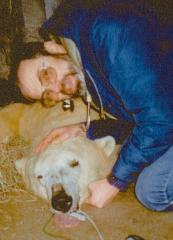
On that same day,you also might find him offering fatherly advice to one ofhis four children (his oldest son is a freshman at Brown),taking a call from the Rhode Island 1 Disaster Medical Assistance Team (RI-1 DMAT),ofwhich he is a member,communicating with his colleagues in the American College ofLaboratory Animal Medicine,squeezing in his volunteer paramedic/firefighter duties with the fire department in his hometown ofSterling Mass., or planning a night out with his wife,Robin,to attend the ballet.
From Dr.Harper’s humble beginnings to becoming the first child in his family to graduate from college,through his years at Penn State and early entry into Penn Veterinary Medicine,and from his service in the Army to time spent in Central America,a NIH fellowship,and working at Brown, he amassed a diverse portfolio ofservice and experience.In fact,the Governor ofRhode Island recognized the entire team,including Dr.Harper,for their work with RI-1 DMAT at Ground Zero.During a 12-day period,he was able to use his emergency medical skills to help the many other rescue personnel [human and canine] on duty.
Dr.Harper is proud ofPenn and strongly believes in the value ofthe education he received.He continues to be deeply motivated and inspired by his students at Brown and those he has mentored at Penn through the Opportunity Scholarship Program (OSP).Established in 1998,the Program is designed to foster scholarship support,provide mentoring opportunities for students and offer alumni a unique opportunity to establish a meaningful connection with future colleagues.
According to Dr.Harper,it was a natural decision for him to fund an Opportunity Scholarship as he enjoys giving back what he had received.He also is cognizant ofthe high debt incurred by students today and how it can impact their career choices.Dr. Harper’s motivation to give back is also inspired by those who motivated him as a student,including Charles W.Raker,V’42 (current chair ofthe OSP committee), Wilbur B.Amand,V’66, Paul Berg, V’62, William B.Boucher,V’40, William

My name is Nate Harvey.I am a fourth year food animal major from Newfield,Maine.Having grown up near my grandfather’s small dairy farm in southern New Hampshire,I’ve always had a particular interest in dairy cows.Since I was a little kid,it has been my dream to attend veterinary school and return to New England to practice dairy medicine. I’m interested in cows from a production standpoint,from a medical and surgical standpoint,and equally as important,from an animal welfare and animal comfort point ofview.It is important for us to realize that our animal production systems are becoming more intensified to meet the growing food demands ofour growing population.However,it also is important that we continue to maintain adequate standards for animal comfort as this happens. One ofthe many valuable lessons I’ve learned on my grandfather’s farm is that “happy cows make more milk,”and it is true for any animal production system– comfortable,healthy animals equal better production.
I am glad to have maintained the important smaller-farm lessons and values that I learned growing up,and I look forward to combining them with the important concepts ofprogressive production medicine that I’m learning here at Penn.Too often, people consider these two lines ofthought (i.e.small farm values vs.large farm production) to be in strict conflict with each other,when actually they both play important roles together in successful production medicine.
This brings me to what I really want to emphasize tonight.While I am fortunate enough to finally be achieving my goals ofpursuing dairy medicine, I could never have made it this far without the unending support ofthe alumni from Penn’s Vet School.I am particularly grateful for the generosity
Donawick, Alan M.Klide,V’65, William Moyer, and Lawrence R.Soma,V’57.
Editor’s Note: Established in 1998,the Opportunity Scholarship Program provides a $10,000 award ($2,500 for each offour years) to a qualified student with demonstrated need while teaming the student with the donor or group of donors in a mentoring process.The program currently supports 40 students.For information on how you can support the future ofveterinary medicine through this program, please contact Dori Myers at the School at 215.746.7438 or via e-mail at dmyers@vet.upenn.edu.
of Dr.Ben Martin,V’80,my Opportunity Scholarship sponsor.I can honestly say that I would not be standing here at this great School,ifnot for his selflessness,as well as that ofthe many alumni here that contribute to relieve students’educational expenses.To all the alumni here tonight who donate your time,your mentorship,and your hard-earned money to the students ofthis School,I would like to remind you that your giving is tremendously appreciated by the students.Your generosity is not taken lightly,and in many cases (such as my own) it can make all the difference between a student not realizing his/her goals,and a student going all the way.IfI could possibly emphasize this enough,I would say it a thousand times… thank you,thank you,thank you.
In conclusion,needless to say,the Huidekoper dinner has become a special annual landmark for me.Each fall I have looked forward to meeting the alumni,enjoying the guest speakers,and cheering on the new first-year Opportunity Scholars.However, my anticipation for this year’s dinner was bittersweet at first,as I realized with disappointment that it would be my fourth and final Huidekoper dinner. Then I quickly realized that,on the contrary,this is not to be my final dinner at all.I will be coming back to enjoy Huidekoper dinners in the future,as a scholarship donor rather than a recipient.IfI can make halfthe difference in my recipient’s life that my donor and all ofyou have made in mine,it will be worth it many times over.
Thank you.
The bats on the new United States postage stamps are getting a lot ofattention.In Pennsylvania,bats have a huge impact on the insect population and are ofgreat benefit to farmers and foresters.However,they remain misunderstood,unappreciated and feared by many.
Bats are the only predators ofnight-flying insects and play a role in controlling many other insect pests.A single bat can consume as many as 500 insects an hour.A colony of100 little brown bats may consume more than a quarter ofa million mosquitoes and other small insects in a night.This is a great help in the control ofWest Nile virus.
Most northeastern bats have just one or two pups a year,usually born in late May or early June.Bats hibernate during the winter (December through March).Recreational cave exploring (spelunking) can threaten the survival ofbat colonies – some caves in the Northeast have gates to limit human access.
Bats have a variety ofhabitats – fields,forest, cities and suburbs.When a lone bat or a colony is found in a building,humans may consider this a problem.The best way to get a lone bat out ofthe house is to let it find its own way out. Confine it to as small an area as possible,and open all windows.It may be necessary to batproofyour home by sealing entrance holes and providing an alternate roost,or bat box.These boxes may be on a pole or in trees but must have seven hours ofsunlight.Because oftheir beneficial role in controlling insects,many people want to attract bats to their yards and gardens by using bat boxes.
A Homeowner’s Guide to Northeastern Bats and Bat Problems is available from Pennsylvania State University (single copies are free of charge).Telephone 814-865-6713 or on the Web at <http://pubs.cas.psu.edu/freepubs/ uh081.html>.
India,a black cat,was brought from Texas to the White House by the Bushes.Socks, Chelsea Clinton’s cat,went to live with secretary Betty Curie when the Clintons left the White House.Jimmy Carter had a Siamese named Misty Malarky Ying Yang.Gerald Ford also had a Siamese,Shan.Presidents Kennedy, Coolidge and Wilson had cats.Theodore Roosevelt had a polydactyl,Slippers.William
McKinley had an Angora.Rutherford Hayes had a Siamese,Siam,said to be the first recorded Siamese in America.Abraham Lincoln was the first White House cat owner.He once said, “No matter how much cats fight,there always seem to be plenty ofkittens.”
The United Kingdom has relaxed its sixmonth quarantine restriction on cats and dogs entering the country from the United States and Canada,provided the animals meet the requirements ofthe UK Pet Travel Scheme (PETS).To qualify,the animal must be fitted with a microchip,vaccinated against rabies (but not before three months ofage) and blood-tested at a recognized laboratory,issued an official PETS certificate and treated against ticks and tapeworms.
The microchip must conform to an ISO standard used in Europe.Many microchips used in America and Canada are not compatible and the owners may need to carry a scanner with them.
Only two laboratories in America are recognized at this time to perform the fluorescent antibody virus neutralization test and one only accepts samples from dogs and cats belonging to the military.The sample should be taken about 30 days after vaccination.There is a six months wait from the time a successful blood sample is taken and entering the UK.
Dogs and cats must be treated against tapeworms and ticks not less than 24 hours and not more than 48 hours before they are checked in to travel,and must have official certification from the USDA and CFIA.

The animals must travel in a container with a seal applied by a government official and on an airline approved for PETS by the UK Government.
It’s possible that the rules may change. More information can be obtained on the PETS Website – <www.defra.gov.uk/animalh/ quarantine/>.
A reader sends: a prickle ofporcupines leap ofleopards cackle ofhyenas
Mule – the sterile offspring ofa mating between a jack (male donkey) and a mare (female horse).

Hinny – progeny ofa stallion and ofa jenny (female donkey),more horse like in appearance than a mule.
Horse hinny – male hinny
Mare hinny – female hinny,also called a molly.
Wether – a male sheep castrated at an early age before secondary sex characteristics have developed.
Bellwether – leader ofthe flock.

Cryptorchid – an animal with undescended testes also called a ridgling (usually a horse) or rig.
In 2002,the American Kennel Club registered 958,503 dogs.This is the first time in many years that the total has been below a million.Labrador retrievers lead the list with more than twice the number ofgolden retrievers, which are in second place.The others in the “Top Ten”are German sheperd dogs,beagles, dachshunds,Yorkshire terriers,boxers,poodles, Chihuahuas and Shih Tzu.
Labradors have led all the breeds every year since 1991.In 2002,154,616 were registered. Almost all breeds had lower numbers than in 2001.Ofthe 150 breeds listed,only 41 showed increased registrations in 2002.Cavalier King Charles spaniels had the largest increase,followed by mastiffs,bulldogs,Havanese,and Portuguese water dogs.Last on the list are otterhounds with only one litter and 17 individual dogs registered.
An Ibizan hound placed first in the Hound Group at Westminster this year.In 2002,this breed ranked 147th,with 50 dogs registered. Jack Russell Terriers,now called Parson Russell Terriers,showed a slight decrease in numbers, although they are very popular on television.
The AKC and breed club web sites are extremely helpful for those thinking about a puppy.Study before you buy.Start with <www.akc.org>.
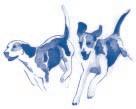
In honor of a special person:
Mr.& Mrs.Jerre Frankhouser ofHammer Creek Farm in honor of their longtime equine veterinarian Edward Mersky,V.M.D.
Mr.Anthony P.Glascock in honor ofSandra Glascock,who chose to forgo Christmas presents to help injured horses.
In honor of Lexie White’s 12th Birthday party:
Karen E.Randolph
Mr.& Mrs.John E.T.Taylor
In the memory of those listed:
Mary Jane Allen in memory ofChristopher Spera
Jean and Wayne Bonde in memory ofGreg Hendrickson
Dr.& Mrs.Luis A.Colon in memory ofWilliam B.Boucher,V.M.D.
Brian A.Kilbourne,V’76 in memory ofArthur Bartenslager,V’37
Mr.& Mrs.Paul J.Seserko in memory ofJohn Heatlie
Mrs.Sara G.Sperling in memory ofDr.F.George Sperling
Ms.Jeanne M.F.Swartchild in memory ofDr.Eric Tulleners
H.Lee Weinrebe,Esq.in memory ofJoseph R.Taraskas
Ellis J.Reeder,III.,in memory ofJoseph R.Taraskas
In honor of a special animal:
Patricia A.Capone in honor of“SHALLOO”
Mr.Peter Fried in the name of“MY LUCKY SON”
Ms.Jerre R.Rausa in honor of“PERCY”
In memory of a special animal:
Mrs.Barbara M.Bauer in memory of“WOODSTOCK”
Marisa Chew in memory of“RASCAL”
Elizabeth W.Glascock in memory of“RUFFIAN”
Constance L Goracci in memory ofDr.Donna Franchetti’s three horses that perished in a barn fire
Christine C.McCarty in memory of“ADOLPH”
Marisa Suvannavejh,Katelyn Ewald and Amy Villano in memory of “ALLY”
The following gift was made to the Farrier Research Fund:
Susan Verbonitz in gratitude to Rob Sigafoos
The following gift was made to the Evan L.Stubbs Research Facility:
Mrs.Sara G.Sperling in memory ofDr.F.George Sperling
The following gifts were made to the Tamworth Fund:
Mr.George Elser and Ms.Angela M.Scully in honor ofHenry Elser and Andrew Elser,V.M.D.
Mr.George Elser and Ms.Angela M.Scully in honor ofMichael and Anne Moran.
The following gifts were made to the Dr.M.Lynn Sammons Award in Bovine Medicine in memory of Dr.M.Lynn Sammons: Dairy Management Consultants,Charles E.Gardner,D.V.M.
Kristin N.Heffner,V.M.D.in honor ofWillow Creek Animal Hospital
Employees and Doctors
Mr.& Mrs.Howard M.Sammons
Dr.Lenora S.Sammons
The following made a gift to the Dr.Ginnie Lieblein Memorial Scholarship Endowment in memory of R.Ginnie Lieblein,V.M.D.
Mr.Walter C.Wells
The folowing gifts were made to the Dr.Eric Tulleners Scholarship Fund in his memory:
Ms.Doris L.Bessette
New Jersey Equine Clinic,Scott E.Palmer,V.M.D.
Nicholas Pesut,Jr.,V.M.D.
Robert M.Thompson,Jr.,V.M.D.
The following gift was made to the Dr.Charles F.Reid Scholarship Fund in his honor:
Emery Castimore,Jr.V.M.D.
The following gift was made to support Epedemiology Studies in honor of those listed:
Mrs.Helen K.Groves in honor ofDr.Jacques Jenny
In memory of a special pet:
Ms.Karen Anstett in memory of“SAM”
The Armstrongs in memory of“AXEL”
Ms.Mary Brightwell Arnold in memory of“MOG WAI”& “SCAMPY”
Ms.Roslyn Barefield in memory of“BO”
Mr.Edward R.Benjamin in memory of“SHADOW”
Ms.Elizabeth M.Bianchi in memory of“NOVA”
Ms.Eugenia B.Bishop in memory of“CH COBLYN’S BLUE LADY OF CARDACH”
Ms.Karen Ramsing Bixler in memory of“SECURION”
Ms.Barbara Black in memory of“MUFFIN”
Mr.and Mrs.Arthur Blank in memory of“CALAMITY JANE”
Mr.and Mrs.Wayne Bonde in memory of“TAMI WOLF”
Ms.Barbara Jean Burns in memory of“CHIVAS”
Mr.and Mrs.William H.Bux in memory of“SNOW PRINCE”
Ms.Frances R.Byers in memory of“LADDIE”
Ms.Jo Etta Campbell in memory of“BEAR”
Ms.Lila Cantor in memory of“BREWSTER”
Mr.and Mrs.David Capuano in memory of“CAMEL
Ms.Donna K.Carlton in memory of“BULLET”
Mr.and Mrs.Guido Cassetta in memory of“PROF PAWS”
Mr.and Mrs.Alfred Cavallaro in memory of“TROOPER”
Mr.and Mrs.Eugenio Chinigo in memory of“BRANDY”,“BIANCA,& “WOLF”
Mr.and Mrs.Thomas V.Clancy in memory of“TROLLEY DOG”
Ms.Paula M.Clark in memory of“OMEY”
Mr.Wayne Conner in memory of“WOTAN”
Mr.and Mrs.William Corcoran in memory of“BARNEY”
Ms.Elizabeth C.Crawford in memory of“COFFEE”
Mrs.Ruth F.Crothers-Spitko in memory of“JOSHUA”
Rev. Douglas W.Dempster in memory of“NOELLE”
Ms.Sharon Dicker in memory of“TORY”
Ms.Jo Alene Dolan in memory of“MIDNIGHT”
Mr.and Mrs.Brian Dorey in memory of“BRANDON”
Mr.and Mrs.Dennis Ecker in memory of“BUMPER”
Dr.Ralph C.Eagle,Jr.in memory of“MISHA”
Mr.and Mrs.Mulford E.Emmel,Jr.in memory of“ABERCROMBIE”
Ms.Katrinka M.Engel in memory of“SUMMER”
Ms.Elizabeth S.Ertel in memory ofall ofher dogs
Mr.and Mrs.Philip Ferrara in memory of“EINSTEIN”
Ms.Edna R.Fleer in memory of“JENNY”
Ms.Lynda Fluitt-Carlin in memory of“DUBY”& “TUFFY”
Mrs.Susan Friel in memory of“MORGAN”
Mr.and Mrs.Peter Hanos in memory of“SNUFFY”,“MAXWELL”,& “MAURICE”
Mrs.Meredith F.Heckler in memory of“MOLLY”& “NELLIE”
Mr.and Mrs.Wilson J.Hipley in memory of“MAJOR”,“GARETH”, “PHELAN”,“NICCI”,& “PAL”
Mr.David M.Howell in memory of“BEAU”
Mr.and Mrs.Joseph Gaudioso in memory of“BONNIE”& “NICOLE”
Ms.Mary Gaorfal in memory of“SPECKS”
Ms.Judith Gelfand in memory of“ZEKE”
Mr.and Mrs.Joseph R.Gionti in memory of“GRIGIO”,“ORPHANO”, “FUJI”
Dr.Doris Goodman in memory of“TAPOOZ”
Mr.and Mrs.Scott Green in memory of“CHAMP”
Mr.and Mrs.E.H.Griffiths in memory of“DORSET”
Mr.Martin C.Gutowski in memory of“THOMAS”
Mr.Stefan Guzy in memory of“JASON”
Mr.and Mrs.John Greaves in memory of“ABBY”
Ms.Beth Hall in memory of“SPENCER”
Mr.Robert Harchut in memory of“ROCKY”& “MAX”
Mr.Henry R.Hecht in memory of“BARNEY”
Mrs.Meredith Heckler in memory of“MOLLY”& “NELLIE”
Mr.Jacob B.Himmelstein in memory of“FRANKIE”
Ms.Frances M.Iadevaio in memory of“MISS KATE”
Mr.and Mrs.Edward James in memory of“ALIE”
Mr.James Jefferson in memory of“BRIDGETT”
Mr.Reginald L.Jones in memory of“CHARLIE”
Ms.Cynthia J.Karhan and Mr.Wes Brush in memory of“TEDDY”& “HUGHIE”
Mr.Barry A.Kaufman in memory of“PRINCESS”
Ms.Joan Kean in memory of“ADAK”
Ms.Ann Kelsey in memory of“HERMAN”
Mr.Al Kerrigan in memory of“SNOOPY”
Mr.and Mrs.Brian Klecko in memory of“BABE”& “DINO”
Mr.and Mrs.K.Koehler in memory of“SPUNKY”
Ms.Maria Komoroski in memory of“MAX”
The Knutson Family in memory of“SMOKEY”
Mr.and Mrs.Joseph B.Kopaczewski in memory of“SCHNAPPS”
Mr.Frank Krupp in memory of“JIGGS”
Mrs.Patricia Lafferty in memory of“HENRY”& “SALLY”
Ms.Sandra Langein in memory of“B C”the cat
Dr.Elizabeth Atwood Lawrence in memory of“SHAMAN”
Ms.Eva C.Leary in memory of“MITSY MIDDEN”
Dr.and Mrs.Ronald D.Luffin memory of“ORANGE”
Ms.Nadine M.Mackey in memory of“OLIVER”& “SUSHINE”
Ms.Karen A.Makara in memory of“THUMPER”
Mr.Gerald I.Magid in memory of“SAM”
Mr.Bruce H.Mann and Ms.Elizabeth Warren in memory of“TROVER”
Ms.Donna Matreale in memory of“KITTY”
Mr.and Mrs.Adam Matteo in memory of“RODNEY”
Dr.Tomi J.McCann in memory of“BUDDY”,“PEDO”,& “SWEET PEA”
Mr.and Mrs.Scott R.McKay in memory of“KI”
Mr.and Mrs.James A.McMillan in memory of“ROCKY”
Mr.and Mrs.David J.Mealmaker in memory of“HARRY JAMES”
Ms.Karen E.Medina in memory of“MEGAN”
Ms.Barbara Miles in memory of“CHIVAS”
Mr.James L.Miller in memory of“RICK”
Ms.Celeste O’Malley in memory of“ANGUS”
Mr.and Mrs.James R.McDonald in memory of“JOSH”
Ms.Kathryn and Marilyn McGeorge in memory of“ROSCO”
Mr.and Mrs.William E.Millhollen in memory of“HERSHEY”& “NUTMEG”
Mr.and Mrs.James E.Mills in memory of“SHILOW”,“KEDRYN”, “MADISON”,“DANA”,& “DEMELZA”
Ms.Lois Morgis in memory of“ULYSSES”,“ARGUS”,“MOOSE”,& “MOUSE”
Mr.and Mrs.Leon Nardini,Jr.in memory of“KELLY”
Ms.Ann K.Ogle in memory of“MITTENS”
Mrs.Catherine M.Olive in memory of“MAI LING”
Mrs.Mary M.Orysiek in memory of“WILLIAM VAN ORANGENASSAO”
Mr.Robert S.Oxley,II in memory of“ANGUS”
Dr.Bernard Paiewonsky in memory of“MAXWELL”
Mrs.Janet E.Parker-Vandenberg in memory of“SHERMAN”
Mr.John Samas and Sonya Peterson in memory of“P.J.”& “OLLIE”
Mrs.Kathleen E.Phelan in memory of“BUDDY”
Ms.Lana R.Pinkenson in memory of“AVI”
Mr.and Mrs.Duarte E.Pinto in memory of“SANDY”
Mrs.Carolyn Baker Pope in memory of“ROMEO”
Ms.Maggie Powell in memory of“ALABASTER”& “ROCKY”
Mr.John J.Prisendorf,Jr.in memory of“TEDDY BEAR”
Mr.Gerard Primavera in memory of“ASHLEY”
Mr.and Mrs.Robert L.Quigley in memory of“TEDDY”
Mr.and Mrs.Robert W.Ralston in memory of“MANDY”
Mrs.Elaine Rapiejko in memory of“MAX”
Mr.David H.Reist in memory of“CANDY”& “PUSSY”
Mr.and Mrs.Warren G.Richards in memory of“KATRINA”
Mrs.Karel A.Rogozenski in memory of“MURPHY”
Ms.Jeanne M.Rogers in memory of“MUFFIN”
Ms.Carol A.Rowehl in memory of“MOLLY”& “ASHLEY”
Mr.Louis G.Rubino in memory of“PATSY”
Mr.Gregg A.Runyen in memory of“JESSIE”& “MEGGIE”
Mr.Philip Rush in memory of“GRETA GARBO”
Mr.and Mrs.Thomas Russo in memory of“BUSTER”
Mr.Dennis Rutkowski in memory of“SLAMMIE”
Mr.and Mrs.Raymond M.Scarduzio in memory of“SAMM”
Mr.Victor E.Schaefer in memory of“TRACY”& “TRINA”
Mr.Paul J.Schoffin memory of“PIPER”
Ms.Randi S.Semanoffin memory of“SADIE” ServiceMaster in memory of“KEISHA”
Dr.and Mrs.Parker M.Seymour in memory of“OBIE”& “CLYDE”
Mr.and Mrs.Gene W.Sharpless in memory of“SANDY”
Mr.and Mrs.James J.Sheridan in memory of“MOZART”
Ms.Marion Shonert in memory of“MICKEY”
Dr.Janediane Smith in memory of“DIXIE”
Mr.Philip Spinelli in memory of“TIGGER”& “NICHOLE”
Ms.Mildred M.Stauffer in memory of“BUDDIE”
Mr.and Mrs.Edward C.Stavenick in memory of“SALLY”
Mr.and Mrs.William W.Sterling in memory of“JINX”and others
Mr.James L.Stowell in memory of“MOLSON”
Mr.Mark A.Stuart and Mr.Tim Rupe in memory of“MEI LING”
Ms.Jennifer Sutherland in memory of“SCRUNGY”
Mr.William M.Sweeney in memory of“SKETTER”
Ms.Sally Thomas in memory of“TOPAZ”
Ms.Marjorie W.Thompson in memory of“TOM”,“LUCIFER”, “SQUIRT”,& “ZICO”
Mr.Donald Travaglini in memory of“FLUFFY”
Ms.Elaine Tsubota in memory of“CHAKO”
Mrs.Marleen Veneziani in memory of“TIGER”
Mr.and Mrs.Darry Voss in memory of“KIDO”
Mr.and Mrs.Jeffrey D.Ward in memory of“CHILLION”
Ms.Wanda May Webb in memory of“CLARENCE”
Mr.George F.Weyhmuller,Jr.in memory of“BUMMER BOY”
Ms.Dianne R.Wilson in memory of“TASHA”
Winston Exetor Fund in memory of“NIKI”
Ms.Barbara Yacos in memory ofall my pets who have passed on
Ms.Patricia Yonekawa and Michael Keegan in memory of“EPHRAM” & “FOSTER”
Dr.and Mrs.Berton Zbar in memory of“GARRETT”
Ms.Joanne C.Zmuida in memory of“MURPHIE”
In memory of Anoush:
Mr.and Mrs.Michael B.Hunzeker
Ms.Diane Sarkisian
Ms.Dorothy J.Towle
In memory of those listed:
Mr.and Mrs.Michael G.Allen in memory ofBud Franklin
Mr.and Mrs.Robert S.Anderson in memory ofGerald J.Grady,Sr.
Ms.Doris M.Bradley in memory ofJay Jasan,V.M.D.
Mrs.Bonnie Brzozowski in memory ofEdward J.Brzozowski
Mrs.Jenevere Carrozza in memory ofMario Carrozza
Mr.John J.Coyle in memory ofDarrell G.Nelson
Friends Life Care at Home in memory ofJack Glover
Ms.Josephine Gaudiosi in memory ofCarol Gaudiosi
Ms.Louise Hutchinson in memory ofHon.Wm.D.Hutchinson
Mr.Norman Katz in memory ofJulio Cordero
Ms.Elizabeth H.McKeon in memory ofRudolph C.Hellinger,Jr.
Mr.Edward M.Resovsky in memory ofJane C.Resovsky
Mrs.John Sacuto in memory ofJohn Sacuto
Mr.Richard Woods in memory ofTerry Woods
Ms.Ethel M.Zell in memory ofMatthew Laudano
In honor of a special pet:
Mr.and Mrs.Michael G.Allen in honor of“CHRISTOPHER”
Mr.Salvatore Amato in honor of“BUTCH”
Ms.Antoinette M.Armstrong in honor of“NATASHA”
Ms.Mary Beck in honor of“HOLLY”
Mr.Stanford A.Bristol in honor of“SPENCER”
Ms.Vivian Bonaventrua in honor of“HEIDI”
Ms.Donna K.Carlton in honor of“JAMES”
Mr.and Mrs.Guido Cassetta in honor of“ZEUS AVENTINUS”
Mr.and Mrs.John Cavanaugh in honor of“ROCKY”
Mr.and Mrs.Charles Clark in honor of“ELLIOT TUCKER”
Mrs.Mary Louise Dietrich in honor of“MAX”,“LEDO”,& “JAZZY”
Ms.Dyanne Disalvo in honor of“A DOG LIKE JACK”
Ms.Yvonne C.Ehrhart in honor of“DIXIE BELLE”
Ms.Sandra Fake in honor of“MOLLY”
Ms.Marjorie Fein-Deutsch in honor of“JESSICA”
Ms.Dawn M.Grasso in honor of“ASHLEY”
Ms.Linda Graycar in honor of“PRECIOUS”
Ms.Tammy James in honor of“RIDLEY”
Ms.Nina Kallmyer in honor of“STEFFIE”
Ms.Patricia Klous in honor of“MOLLY”
Mrs.Jane F.Markham in honor of“MCDUFF”
Ms.Maggie Powell in honor of“NICO”
Ms.Kelly Rafus and Mr.Steven Franco in honor of“JASPER”
Mr.Kirk A.Rebane in honor of“SALTZWATER”
Mr.and Mrs.James O.Singer in honor of“SNOWDON”
Drs.Marian and Robert Slater in honor of“CHELSEA”13th Birthday
Mr.and Mrs.Darry Voss in honor of“BEAR”,“NIKI”,& “SERGEI”
Mr.and Mrs.Alan R.Werner in honor of“FOSTER”
In honor of those listed:
Mr.and Mrs.Michael G.Allen in honor ofDavid J.Phillips,Jr.
Mr.and Mrs.Michael G.Allen in honor ofChristopher Spera
Mr.and Mrs.William H.Bux in honor ofthe staffofRav Animal Hospital
Ms.Diana Contine in honor ofGary Abelor
Ms.Denise B.Carr and Mr.James D.Lowry in honor ofDr.Judith Durkee
Mr.and Mrs.Andrew Cruz in honor ofGeneve Cruz
Dr.and Mrs.Edward V.Dillon in honor ofDr.St.George Hunt
Mr.and Mrs.John E.Falcichio in honor ofMichael B.McDonnell
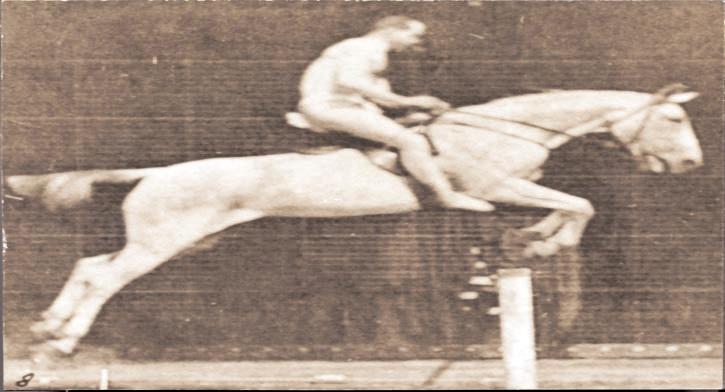
A life income gift can help you to stretch your charitable giving resources. Charitable remainder trusts and charitable gift annuities are tax-deductible contributions that allow you to keep income from the assets that you donate. Proceeds go to the School of Veterinary Medicine,Ryan Veterinary Hospital or New Bolton Center after your death.
• With rates at 5% to 9.5%,you might even double or triple your return.
• You will enjoy significant tax savings.
• Some plans pay tax-exempt income.
• It’s like the Trifecta of charitable giving.
To learn more,please consult our gift planning expert: Janine Ehsani,Office of Gift Planning, 215-898-6171 or 1-800-223-8236,ehsani@ben.dev.upenn.edu.
Mr.and Mrs.Stephen J.Garry in honor ofKathy Garry’s love of Animals
Ms.Helen Hiller in honor ofDr.Susan Jacobson
Ms.Tammy James in honor ofDr.Chick Weisse
Ms.Beth E.Liddle in honor ofDr.Dan Morris
Ms.Jean S.Madsen in honor ofMrs.Robert V.Clark,Jr.and Mrs.Edith
M.Young
Mr.and Mrs.Clark Mac Mullen in honor ofDr.Neath and the staffof VHUP
“Star”Polisano in honor ofLeo A.Polisano
Mrs.Carolyn Baker Pope in honor ofDr.Jacqueline Metzler
Dr.and Mrs.Bruce Singer in honor ofLorrie Holt
Ms.Rosalyn Richman in honor ofDr.Jennifer Smelstoys
Mr.Richard C.Schneider in honor ofAlison Seward
Mr.Jonathan Weinstein and Sarah Jordan in honor ofDr.Stephen Cole,V.M.D.
The following have made gifts to the Clinical Studies Research Development Fund in memory of a special pet:
Ms.Margaret J.McMonagle in memory of“SHADOW”
Ms.Nancy Sullivan in memory of“DELLA;”“NICOLE;”and “LUNCHWAGON”
THE FOLLOWING HAVE MADE GIFTS TO CLINICAL RESEARCH:
In memory of a special pet:
Mr.and Mrs.Richard G.Dominique in memory of“MAXX”
In memory of those listed:
Mr.Stanford A.Gordon in memory ofAnita B.Gordon
In honor of a special pet:
Mr.and Mrs.Robert W.Ralston in honor of“MANDY”
The following made gifts to the Special Species Clinic in memory of a special pet:
Mr.and Mrs.Denis Roark in memory of“DJ”,“SNEEZIE”,“SARAH”, and “ADAIR”
University ofPennsylvania School ofVeterinary Medicine
Editor
Helma Weeks
Photographers
Jon Adams
Addison Geary
James E.Hayden
Doug Thayer
Writers
Margaret Hiza Ardington,V.M.D.
Stephen Bradt
Josephine Deubler,V.M.D.
Joan Capuzzi Giresi,V.M.D.
Natahn D.Harvey,V'03
Katherine Kruger
Lori Spencer Mann,V.M.D.
Jonathan Palmer,V.M.D.
Raymond W.Stock,V.M.D.
Regina Turner,V.M.D.
Helma Weeks
Alumni Relations Liaison
Joshua E.Liss
New Bolton Center Liaison
Jeanie Robinson-Pownall
We’d like to hear your praise,criticisms,or comments. Please address your correspondence to:
Helma Weeks
University ofPennsylvania
School ofVeterinary Medicine
3800 Spruce Street
Philadelphia,PA 19104-6010
(215) 898-1475
hweeks@vet.upenn.edu
None ofthese articles are to be reproduced in any form without the permission ofthe editor of Bellwether
©Copyright 2003 by the Trustees ofthe University ofPennsylvania.
The University ofPennsylvania values diversity and seeks talented students,faculty and stafffrom diverse backgrounds.The University ofPennsylvania does not discriminate on the basis ofrace,sex,sexual orientation,religion, color,national or ethnic origin,age,disability,or status as a Vietnam Era Veteran or disabled veteran in the administration ofeducational policies,programs or activities;admissions policies;scholarship and loan awards;athletic,or other University administered programs or employment. Questions or complaints regarding this policy should be directed to:Executive Director,Office ofAffirmative Action and Equal Opportunity Programs,3600 Chestnut Street, Sansom Place East,Suite 228,Philadelphia,PA 19104-6106 or (215) 898-6993 (Voice) or (215) 898-7803 (TDD).
The following made gifts supporting Dr.Giger’s mucopolysaccharidosis research in memory of a special pet:
Shelly Goldman Black and Johnny Black in memory of“GILLIGAN”
THE FOLLOWING MADE GIFTS TO THE RADIATION THERAPY FACILITY FUND:
In honor of those listed:
Mr.and Mrs.Havey Kostinsky in honor ofDr.Brady Beale and Dr.Watson
In memory of a special pet:
Mr.and Mrs.Mark E.Derricks in memory of“GATSBY”
In honor of a special pet:
Mr.David O.Bauldree in honor of“PATCHES”
Mr.and Mrs.David E.Dockety in honor of“HONEY”
Mr.Francis X.Hughes in honor of“BUFFY”
Ms.Cornelia Schlotter and Marcella Kimmick in honor of“BAGGY BEAR”& “HONEY BEAR”
THE FOLLOWING MADE GIFTS TO SUPPORT ONCOLOGY RESEARCH:
In memory of a special pet:
Mr.and Mrs.Mark Blasko in memory of“BAILEY”
Ms.Catherine Ciric in memory of“BU”
Mr.and Mrs.Bruce B.Cummings in memory of“BAILEY”
Mr.and Mrs.John Scala in memory of“BABY”
In honor of those listed:
Mr.and Mrs.Mark Blasko in honor ofDr.Clifford
Ms.Karen Toczydlowski in honor ofDr.Lili Duda and Mr.Scott Gilligan
The following made gifts supporting the Penn Animal Blood Bank in memory of a special pet:
Mr.and Mrs.Steve Chappell in memory of“BARCLAY”
The following made gifts supporting Dr.Beth Callan’s Research in memory of a special pet:
Ms.Rosemary Whitaker in memory of“REDBOY”
The Following made gifts to Dr.Cynthia Otto’s Search and Rescue Dog Research Fund in memory of a special pet:
Mr.and Mrs.Warren Sewall in memory of“MOLLIE”,“BABE”, “DIGBY”
THE FOLLOWING CONTRIBUTED TO THE HUMANITARIAN FUND:
In memory of a special pet:
Mr.and Mrs.Joseph J.Bohovic in memory of“CLANCY”
In memory of “MacDuff”:
Ms.Heather L.Hillman
Mr.Conrad W.Nelson
Ms.Christina A.Nelson
In honor of a special pet:
Mr.Conrad W.Nelson in honor of“MAXWELL”
In honor of “GEORGE”:
Ms.Heather L.Hillman
Mr.Conrad W.Nelson
Ms.Christina A.Nelson
In honor of those listed:
Mr.and Mrs.Lathrop B.Nelson in appreciation for the wonderful care given by Dr.Kim Slensky,Dr.Kathleen Meehan and the entire ICU staff
Ms.Christina A.Nelson in honor ofthe ICU staff
THE FOLLOWING CONTRIBUTED TO THE DEAN’S FUND:
In memory of a special pet:
Mr.and Mrs.Curt Adams in memory of“CORDELIA”
Mr.and Mrs.Richard Del Bono in memory of“WRINKLES”
Dr.Leo Brukman in memory of“SIR KOKO”
Ms.Helen Little in memory of“PUGIE”
Mr.and Mrs.Cornelius C.O’Brien III in memory of“CASEY”
THE FOLLOWING CONTRIBUTED TO THE VETERINARY STUDENT SCHOLARSHIP FUND:
In memory of those listed:
Burleigh P.Anderson,V.M.D.in memory ofRichard Derstine
Leslie A.Hoffman,V.M.D.in memory ofDr.R.D.Hoffman
Brian A.Kilbourne,V.M.D.in memory ofDr.Arthur V.Bartenslager
Mrs.Susan S.Leiper in memory ofIsaac Tomlinson Tyson
Dr.Nicholas G.Loutsion in memory ofGeorge and Kula Loutsion,Sr. Physchiatry Management Services in memory ofDavid Goldblatt and Libby Cohen
Mrs.Sara G.Sperling in memory ofDr.F.George Sperling
In memory of a special pet:
Leo Brukman,V.M.D.in memory of“SIR KOKO”
Jackie Paul Entertainment Group,Inc.in memory of“GEO”
Robin P.Pullen,V.M.D.in memory of“FRANKLIN”
Dr.Susan V.Westmoreland in memory of“RUBY”
In honor of those listed:
Michael S.Miller,V.M.D.in honor ofDavid K.Detwiler,V.M.D.
Paul H.Nicolaysen,V.M.D.in honor ofPeggy Danneman,V.M.D.
The following contributed gifts to the Class of 1957 Endowed Scholarship Fund in memory of those listed:
Dr.and Mrs.Burton E.Anderson in memory ofDr.Richard Derstine
The following contributed gifts to the Class of 1957 Endowed Scholarship Fund in honor of those listed:
Charles L.Putnam,V.M.D.in honor ofRichard Derstine,V.M.D.
Roger G.Smith,Jr.,V.M.D.in honor ofthe Class of1957
The following contributed gifts to the M.Josephine Deubler Scholarship Fund in memory of those listed:
Mr.Thomas A.Deubler in memory ofDr.James A.Deubler
The following contributed gifts to the E.R.Marookian Research Scholarship Fund in honor of E.R.Marookian,V.M.D.:
Mr.Edward Robert Bazarian
The following contributed gifts to the Jay Jasan Endowed Scholarship Fund in memory of Jay Jasan,V.M.D.:
Mr.and Mrs.Albert O.Botto
The following contributed gifts to the Teaching and Research Building Fund in honor of those listed:
Henry L.Croft,Jr.,V.M.D.in honor ofMr.and Mrs.Henry Croft,Sr.
The following contributed gifts to the Teaching and Research Building Fund in memory of a special pet:
Amy Anderson,V.M.D.in memory of“DAGMAR”
Do you or anyone you know have a piano that isn’t wanted anymore? Why not donate it to the Flea Club? We are Penn Veterinary Medicine’s premiere singing group composed ofstudents,faculty and staff.Currently we have about 15 members,and we practice once a week and give concerts at the end ofevery semester and during the Annual SCAVMA Auction.
Now we’re looking for your help,as our
by Emily Jones,V’05,Flea Club Directorone-legged,sticky-keyed piano continues to deteriorate.We all love singing and providing entertainment to the School community.We sing everything from popular music to religious and secular holiday favorites.So ifyou can help us continue to do that by helping us find a new piano,we’d love to hear from you!
Ifyou are able to help or ifyou have any questions,please contact me via e-mail at <ecj@mail.vet.upenn.edu>.Thanks a lot!
At the annual Thoroughbred Charities ofAmerica auction,held on December 7 at Herb and Ellen Moelis’Candy Land Farm in Bohemia,Md., Mrs.Elizabeth Moran was honored by Thoroughbred Charities ofAmerica and by the School.
Herb Moelis,W’53,president ofThoroughbred Charities ofAmerica,made the presentation ofthe Allaire duPont Humanitarian Award to Elizabeth Moran,recognizing her generous and continued support ofvarious equine-related charities and especially her long standing support ofNew Bolton Center.He also noted that beyond the equine charities,Betty’s philanthropic endeavors were wide spread.For instance,when the horrific events of9/11 occurred, Betty was one ofthe first to offer financial support to the Hero’s Fund.Herb further explained that the T.C.A.had very much wanted to honor Betty long before this,but when Betty was asked,she said absolutely,positively not.Finally,the organization simply decided to proceed with the honor in 2002, without her having any advance knowledge.After the presentation her comment was “had I known about it, I would have dressed for the occasion.”According to Ellen Moelis,“How gracious and so typically Betty.A true Grand Dame ofracing,a true philanthropist and a wonderful person.”
Betty Moran has had many winning horses and is one ofthe people in racing who had winners in both the Thoroughbred Classics and the Grand National Steeplechase.
After Herb Moelis’presentation, Dean Alan Kelly honored Mrs.Moran by presenting the School’s silver Bellwether Medal to her,the Veterinary School’s highest honor.He read the following citation:

Elizabeth (Betty) Moran has been a staunch friend to the School ofVeterinary Medicine for more than forty years.Her early association with the late Mark Allam,a beloved friend,and her use ofthe New Bolton Center’s clinical facilities forged a bond ofmutual respect and affection that grows with each passing year.With insight, vision and unparalleled kindness,Betty’s gifts have allowed New Bolton Center to grow in excellence and have greatly enhanced the Center’s ability to cure the ailing horse.Her love ofThoroughbreds and commitment to their well being is manifest in all she has done and continues to do for the School ofVeterinary Medicine.
New Bolton Center has the reputation ofbeing the finest equine clinic in the world,a preeminence that would have been unattainable without Betty Moran. Her philanthropy scintillates and inspires.No institution could ask for a more generous and caring friend.
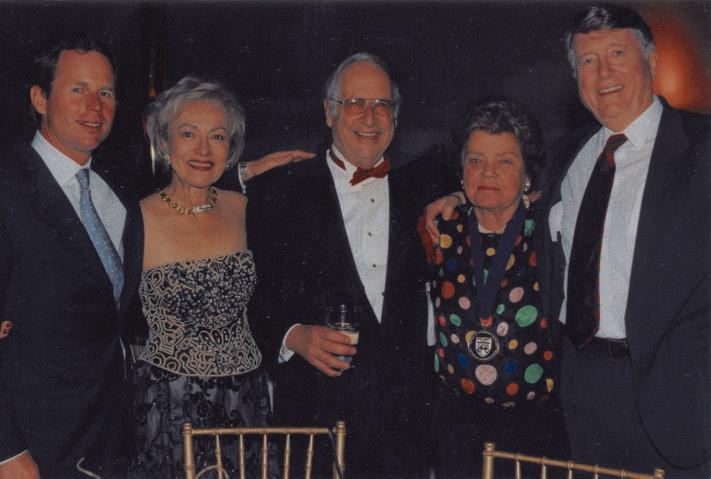

So,it is with great pride that the University of Pennsylvania School ofVeterinary Medicine awards the first silver Bellwether Medal to Elizabeth R.Moran.

May 2003
14
2:00-4:00 p.m.
Veterinary Medical Alumni Society Executive Board Meeting
Ryan Veterinary Hospital at Penn
16
2:00-3:00 p.m.
Alumni Weekend 2003 Classes Without Quizzes Presentation
“Antibiotic Resistance:Malice in Wonderland” by Dr.Shelley C.Rankin,Assistant Professor Clinician Educator ofMicrobiology Houston Hall,Golkin Room 3417 Spruce Street
Antibiotic resistant bacteria:Ever wondered what all the fuss was about? Dr.Shelley Rankin tells it from the bugs' perspective.What is an antibiotic,how and why do bacteria develop resistance to antibiotics and what can we do to combat the “super-bugs”ofthe future?
17
Alumni Weekend 2003/Reunions for Classes ending in “3”or “8” For information,visit <http://alumni.vet.upenn.edu/alumniweekend2003. htm>.
19
School of Veterinary Medicine Class of 2003 Commencement
For information,visit <www.upenn.edu/ commencement/>.
June 2003
13-15
An Evening in Old Philadelphia
Sponsored by the Evening at Old Saratoga Committee to benefit New Bolton Center and the historic Devon Show Grounds in Devon,Pa.
Fabulous antique vehicles drawn by teams ofone, two or four horses will parade through Philadelphia and its countryside.A black tie gala dinner-dance and silent auction will be held at “Ardrossan”— fabled home that inspired the movies,“The Philadelphia Story”and “High Society.”
For information,contact Pat Hall at (610) 444-5800 x2500 or via e-mail at <phall@vet.upenn.edu>.
July 2003
20
6:30-8:30 p.m.
Alumni Reception
American Veterinary Medical Association
Annual Convention Plaza F
Adam’s Mark Hotel Denver,CO
For information,contact Joshua Liss at (215)8981481 or via e-mail at <lissj@vet.upenn.edu>.
Fall 2003
Equine Short Courses for Horse Owners and Veterinarians
New Bolton Center
For information,visit <www2.vet.upenn.edu/labs/ equinebehavior/02-03Courses/crs02-03.htm>.
March 2004
11-12
2004 Penn Annual Conference
Adam’s Mark Hotel
Philadelphia,PA
For information,contact Amy Bogdanoffat (215) 898-4234 or via e-mail at <bogdanof@vet.upenn.edu>.
Important Phone Numbers
Matthew J.Ryan Veterinary Hospital of the University of Pennsylvania
24-Hour Emergency Service(215) 898-4685 Specialist Clinic Appointments(215) 898-4680
George D.Widener Hospital for Large Animals at New Bolton Center 24-Hour Emergency Service and Specialist Clinic Appointments(610) 444-5800
School of Veterinary Medicine General Information(215) 898-5438
3800 Spruce Street
Philadelphia, PA 19104-6008
Address Service Requested